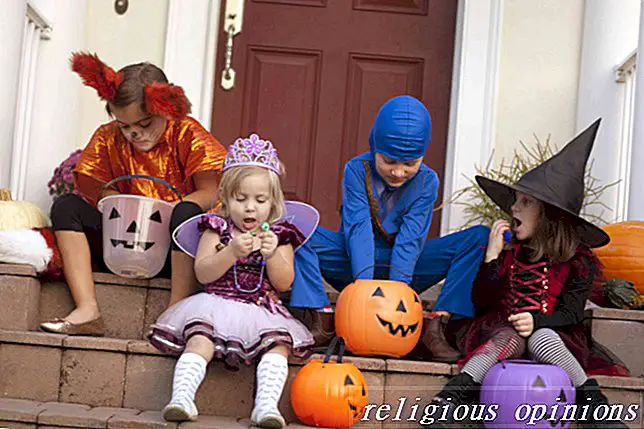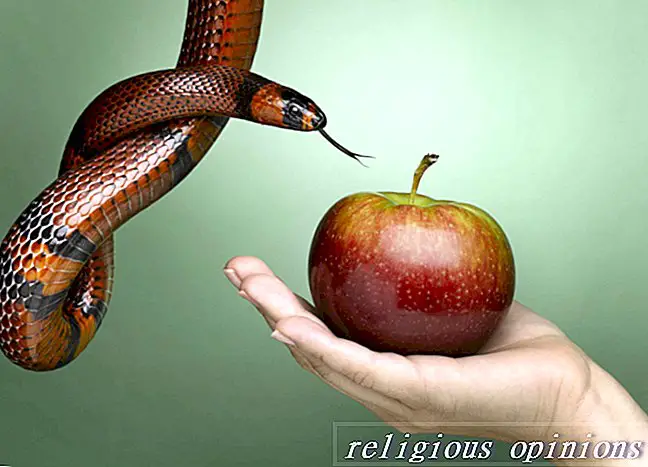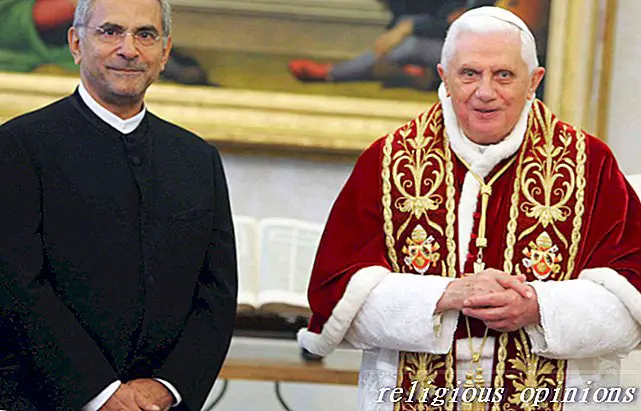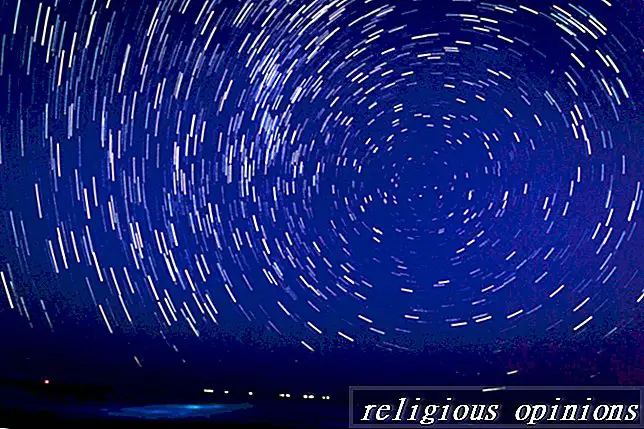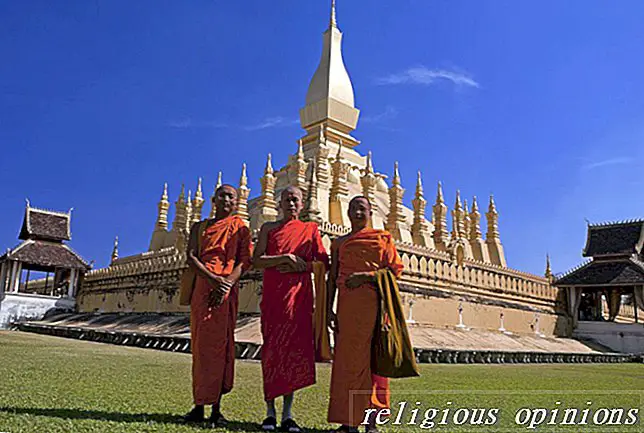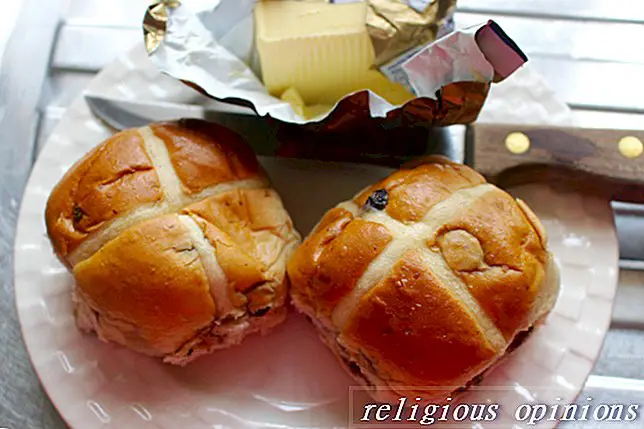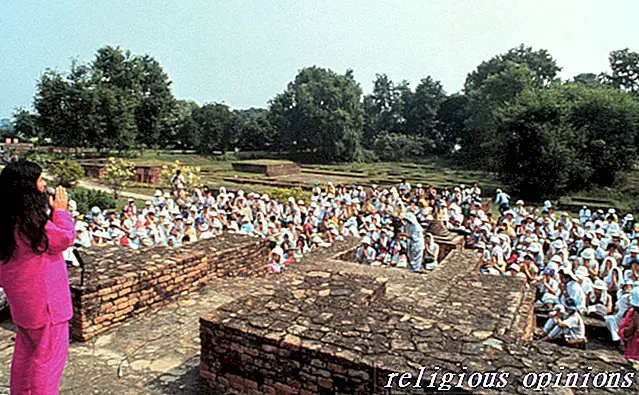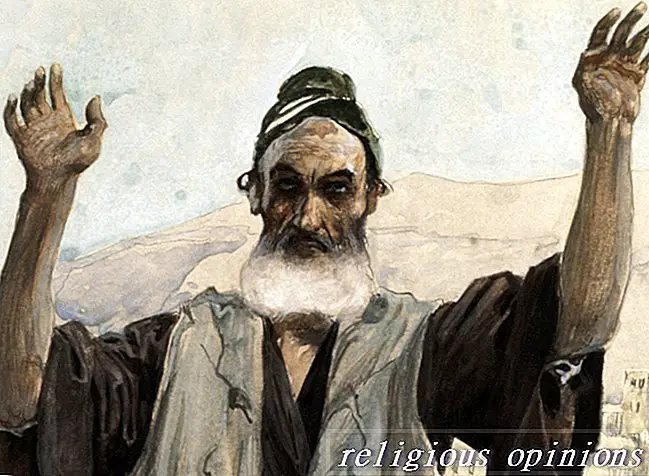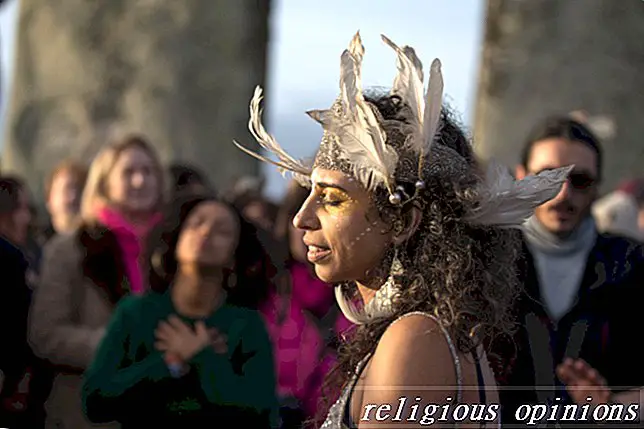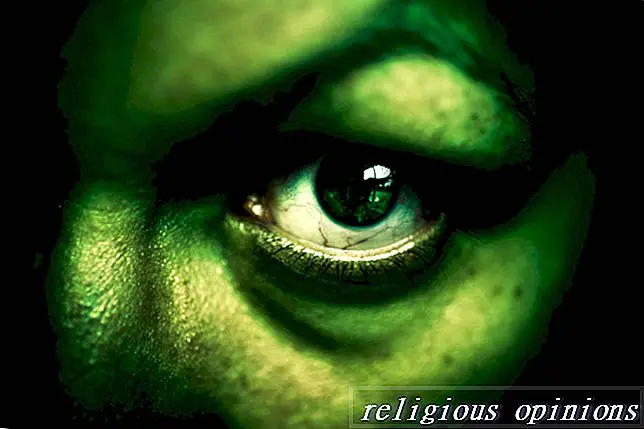O roteiro Gurmukhi de Gurbani has 35 akhar, ou consoantes, idêntico ao alfabeto do paine Punjabi, incluindo três detentores de vogais e 32 consoantes. Cada personagem representa um som fonético. Ordem alfabética da escrita Gurmukhi é totalmente diferente do alfabeto Inglês. Gurmukhi akhar é baseado em agrupamentos que possuem certas semelhanças e é organizado em uma grade de cinco linhas horizontais e sete linhas verticais com propriedades específicas de pronúncia (que não são mostradas aqui). Cada letra tem uma combinação de características dependendo de sua posição horizontal e vertical. Algumas letras são pronunciadas com a língua tocando a parte de trás dos dentes superiores ou enroladas para trás para tocar logo atrás da crista no céu da boca. As letras podem ser pronunciadas com uma lufada de ar ou exigir que se retenha o ar. Alguns personagens têm um som nasal.
Os versos de Gurbani têm um significado espiritual nas escrituras sikh e contêm passagens metafóricas nas quais figuram as várias letras Gurmukhi. A grafia fonética das letras nas traduções varia.
01 de 36Guia de pronúncias de Gurmukhi Oorraa
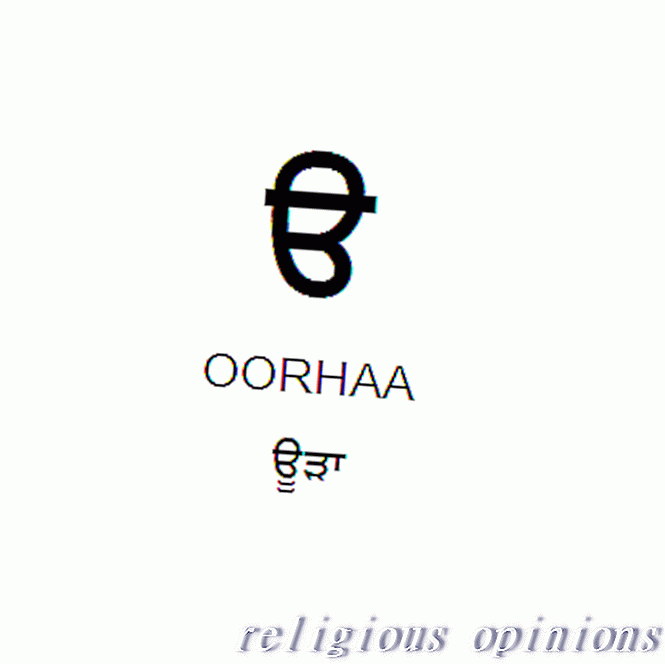 Punjabi Akhar Oorraa de Gurbani Significância em Escritura Sikh Oorraa Gurmukhi Detentor de Vogal. Foto [S Khalsa]
Punjabi Akhar Oorraa de Gurbani Significância em Escritura Sikh Oorraa Gurmukhi Detentor de Vogal. Foto [S Khalsa] Oorraa é o primeiro dos três titulares de vogais que aparecem na escrita Gurmukhi de Gurbani e é idêntico aos detentores de vogais do alfabeto punjabi (akhar).
Oorraa é pronunciada com ênfase igual em sílabas e sons como ewe-raw. Oorraa é usada no começo de uma palavra onde o primeiro som é o de uma vogal ou de qualquer palavra onde a vogal não é precedida por uma consoante como no caso de um som de vogal dupla e tem sons de vogais específicos atribuídos a ela. A ortografia de Oorraa é fonética e pode aparecer também como Oorhaa . As grafias podem diferir ligeiramente em Gurmukhi original, bem como em traduções romanizadas e inglesas de Gurbani.
Significância de Oorraa na Escritura Sikh
A escritura sikh inclui a forma acróstica do verso poético escrito pelo Primeiro Guru Nanak Dev quando jovem, quando recebe uma lição de casa na escola para escrever o alfabeto. Sua professora expressou espanto quando a criança Nanak Dev escreveu:
" Oorrai oupmaa taa kee keejai jaa kaa ant na paa-i-aa ||
ORARAA: Cante em louvor de alguém cujos limites não podem ser descobertos. "SGGS || 432
02 de 36Guia de pronúncias de Gurmukhi Airraa
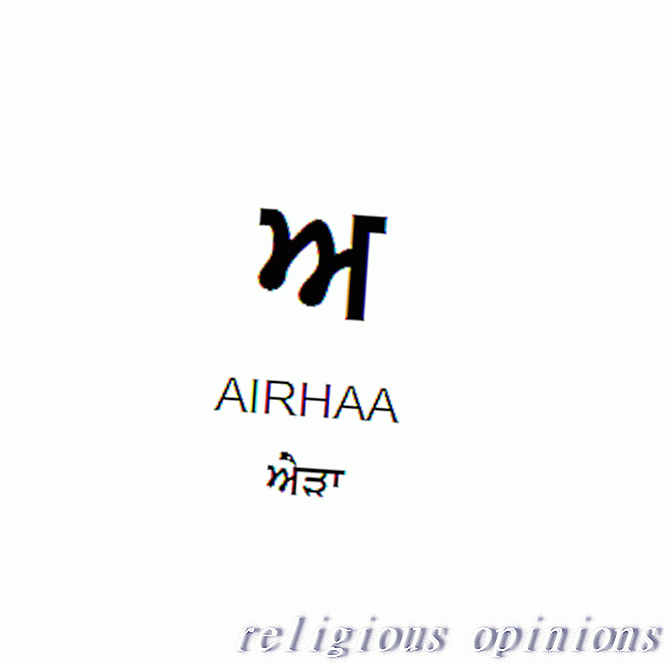 Punjabi Akhar Airraa de Gurbani Significância em escritura sikh Airraa Gurmukhi titular de vogal. Foto [S Khalsa]
Punjabi Akhar Airraa de Gurbani Significância em escritura sikh Airraa Gurmukhi titular de vogal. Foto [S Khalsa] Airraa é o segundo de três titulares de vogais que aparecem na escrita Gurmukhi de Gurbani e é idêntico aos detentores de vogais do alfabeto Punjabi Paintee.
Airraa é pronunciado com ênfase nas segundas sílabas e soa como era ou err-raw. Airraa é usado no começo de uma palavra onde o primeiro som é o de uma vogal ou de qualquer palavra onde a vogal não é precedida por uma consoante como no caso de um som de vogal dupla e tem sons de vogais específicos atribuídos a ela. A grafia de Airraa é fonética e pode aparecer também como Airhaa . As grafias também podem diferir ligeiramente em Gurmukhi original, bem como em traduções romanizadas e inglesas de Gurbani.
Significado de Airraa na Escritura Sikh
Escritura sikh inclui forma acróstica do verso poético escrito por Guru Nanak Dev o estudioso como um jovem rapaz quando dado um trabalho de casa na escola para escrever o alfabeto. Sua professora expressou espanto quando a criança Nanak Dev escreveu:
" Aa-i-rrai aap karae jin chodede jo kichh karnaa su kar rehi-aa ||
AIRRA: Ele mesmo criou o mundo, o que quer que seja feito, Ele continua fazendo. "SGGS || 434
Guia de pronúncias Gurmukhi Eerree
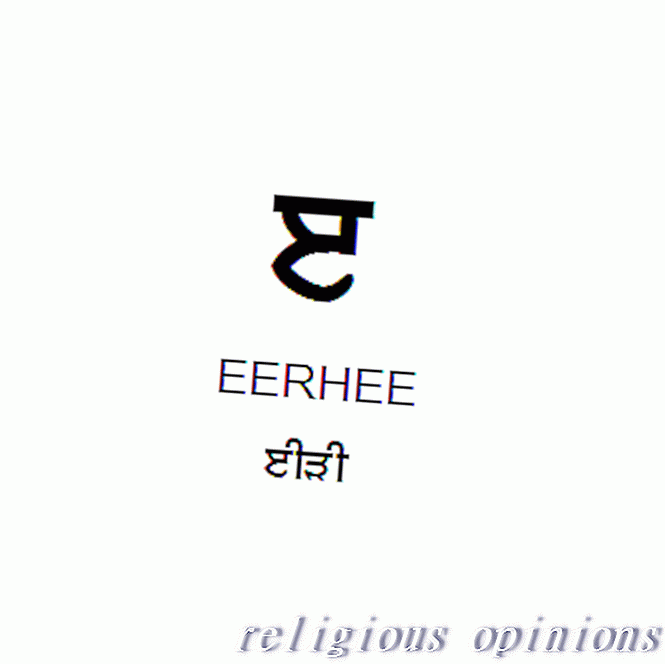 Punjabi Akhar Eerree de Gurbani Significância em Escritura Sikh Eerree Gurmukhi Detentor de Vogal. Foto [S Khalsa]
Punjabi Akhar Eerree de Gurbani Significância em Escritura Sikh Eerree Gurmukhi Detentor de Vogal. Foto [S Khalsa] Eerree é o terceiro de três titulares de vogais que aparecem na escrita Gurmukhi de Gurbani e é idêntico aos detentores de vogais do alfabeto Punjabi Paintee.
Eerree é pronunciado com ênfase nas segundas sílabas e soa como era ou err-raw. Eerree é usado no começo de uma palavra onde o primeiro som é o de uma vogal ou de qualquer palavra onde a vogal não é precedida por uma consoante como no caso de um som de vogal dupla e tem sons de vogais específicos atribuídos a ela. A ortografia de Eerree é fonética e também pode aparecer como Eerhee ou Iri . As grafias também podem diferir ligeiramente em Gurmukhi original, bem como em traduções romanizadas e inglesas de Gurbani.
Significado de Eerree na Escritura Sikh
Primeiro Guru Nanak impressionou seu professor com suas percepções espirituais quando recebeu uma tarefa na escola para escrever o alfabeto:
" Eevrree aad purakh ha daataa aapae sachaa so-ee ||
EEVRREE: O Senhor Primevo é o doador, Ele só é verdadeiro. "SGGS || 432
04 de 36S - Gurmukhi Sassa - Guia de pronúncias
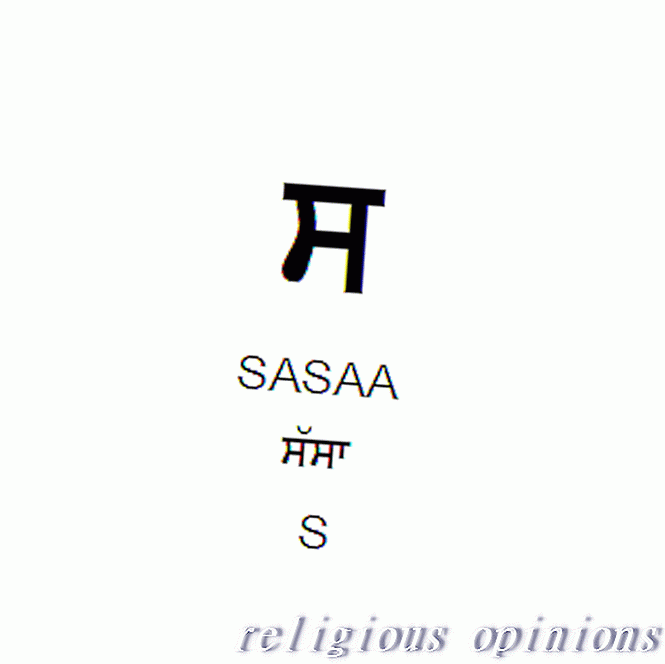 Punjabi Akhar Sassa de Gurbani Significância na Escritura Sikh Gurmukhi Script Sassaa. Foto [S Khalsa]
Punjabi Akhar Sassa de Gurbani Significância na Escritura Sikh Gurmukhi Script Sassaa. Foto [S Khalsa] Sassa é uma das 35 consoantes da escrita Gurmukhi de Gurbani e idêntica ao alfabeto Punjabi. As consoantes de Gurmukhi são conhecidas como 35 Akhar.
Sassa tem o som de S e é pronunciado com ênfase na segunda sílaba como sa-saw. A grafia romanizada de Sassa é fonética e pode aparecer também como Sassaa . As grafias podem diferir ligeiramente em Gurmukhi original, bem como em traduções romanizadas e inglesas de Gurbani.
Significado de Sassa na Escritura Sikh
A escritura sikh inclui várias formas acrósticas do verso poético escritas pelos autores do Guru Granth Sahib:
" Sasai soe sristt jin saajee sabhnaa saahib aek bha-i-aa ||
SASSA: Aquele que criou o mundo, é de todos o único Senhor Mestre. Primeiro Guru Nanak Dev SGGS || 432
" Sasai sabh jag sehaj oupaa-i-aa adolescente bhavan ik jotee ||
SASSA: O universo inteiro Ele criou com facilidade, iluminando os três reinos com uma luz. "Primeiro Guru Nanak SGGS || 930
Outros versos acrósticos com Sasaa em Gurbani incluem autores:
Quinto Guru Arjan Dev:
" Sasaa saran parae ab haarae ||
SASSA: Seu santuário eu agora entrei em O Senhor. "SGGS || 260
"Sasaa siaanap chhaadd iaanaa ||
SASSA: Desista da sua esperteza Ó tolo ignorante. "Guru Arjan Dev SGGS || 260
Bhagat Kabir:
" Sasaa so neekaa kar sodhahu ||
SASSA: Disciplina a mente com perfeição sublime. "HagBhagat Kabir SGGS || 342
" Sasaa so seh saej savaarai ||
SASSA: A cama da noiva-alma é adornada com a presença do seu Marido Senhor. "Bhagat Kabir SGGS || 342
Terceiro Guru Amar Das:
" Sasai sanjam ga-i-ou moorrae aek daan tudh kuthaa-e la-i-aa ||
SASSA: Você perdeu a autodisciplina, ó tolo, e aceitou ofertas sob falsos pretextos. " SGGS || 345
H - Guia de pronúncias de Gurmukhi Haahaa
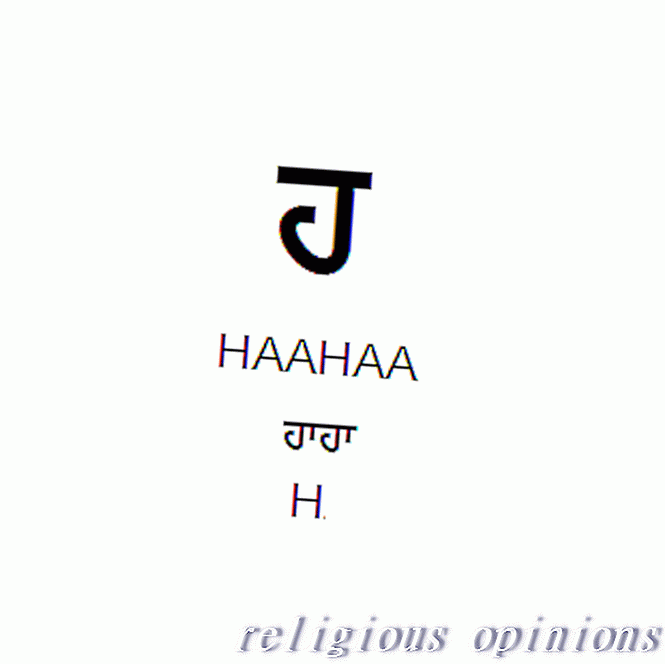 Punjabi Akhar Haahaa Significância na Escritura Sikh Gurmukhi Script Haahaa. Foto [S Khalsa]
Punjabi Akhar Haahaa Significância na Escritura Sikh Gurmukhi Script Haahaa. Foto [S Khalsa] Haahaa é uma consoante da escrita Gurmukhi akhar do Guru Granth Sahib e é quase idêntica ao alfabeto do paine Punjabi.
Haahaa representa um som H como em ha-ha, com igual ênfase é dada a ambas as sílabas e é pronunciada de forma que, quando falada, há um sopro de ar sentido quando a mão é mantida na frente dos lábios. A grafia romanizada de Haahaa é fonética e pode aparecer também como Haha . As grafias podem diferir ligeiramente em Gurmukhi original, bem como em traduções romanizadas e inglesas de Gurbani.
Significado nas Escrituras Sikhs
A escritura sikh inclui versos poéticos apresentando Haahaa escrito por Primer Guru Nanak Dev como um estudante quando designado para escrever o alfabeto. Sua professora expressou espanto quando a criança Nanak Dev escreveu:
" Haahai hor na koee daataa jeea oupaae jin rijak deeaa ||
HAHA: Não há outro Doador além daquele que criou as criaturas que lhes dá alimento. "SGGS || 435
Outras composições poéticas dos autores de Gurbani apresentando Haahaa incluem:
" Haahaa enxada quente nehee jaanaa ||
HAHA: Ele existe, mas não se sabe que existe. "HagBhagat Kabir SGGS || 342
" Haahai har kathaa boojh toon moorrae taa sadhaa sukh hoee ||
HAHA: Entenda o discurso divino Ó tolo, pois somente então você alcançará a paz eterna. " Terceiro Guru Amar Das SGGS || 435
Gurmukhi Alfabeto Kakaa de Gurbani Ilustrado com Pronúncia
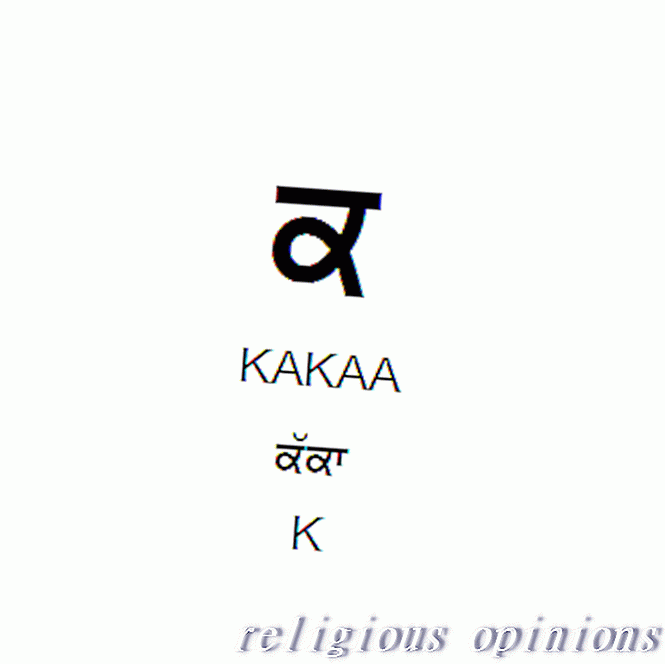 Punjabi Akhar Kakaa de Gurbani Significância na Escritura Sikh Gurmukhi Script Kakaa. Foto [S Khalsa]
Punjabi Akhar Kakaa de Gurbani Significância na Escritura Sikh Gurmukhi Script Kakaa. Foto [S Khalsa] Kakaa é uma consoante do alfabeto Gurmukhi.
K - Guia de Pronúncia de Gurmukhi Kakaa
Kakaa é uma consoante do roteiro de Gurmukhi e é quase idêntica ao alfabeto de Punjabi Paintee.
Kakaa é pronunciado como cka ckaaw (caw), com ênfase na segunda sílaba. Não deve haver sopro de ar quando a mão é segurada na frente dos lábios. A grafia romanizada de Kakaa é fonética e pode aparecer também como Kakka . As grafias podem diferir ligeiramente em Gurmukhi original, bem como em traduções romanizadas e inglesas de Gurbani.
Significado de Kakaa nas Escrituras Sikhs
A escritura sikh inclui a forma acróstica do verso poético em seleções em todo o Guru Granth Sahib.
Primeiro Guru Nanak Dev, surpreendeu seus instrutores quando, quando menino, dava uma lição de casa na escola para escrever o alfabeto, a criança respondia com um acróstico espiritual:
" Kakai kes punddar jab hoo-ae vin saaboonai oujaliaa ||
KAKKA: Quando o cabelo fica branco, sem lavar, brilha. "SGGS || 432
Outros versos acrósticos com Kakaa em Gurbani incluem:
" Kakaa kaaran karataa so-oo ||
KAKKA: Ele é a causa, criação e Criador. "SGGS || 253 Quinto Guru Arjan Dev
" Kakaa kiran kamal meh paavaa ||
KAKKA: A luz do conhecimento divino ilumina o coração de lótus com seu raio. " SGGS || 340 Bhagat Kabir
" Kakai kaam krodh bharami-o-hu mooré mamtaa laagae tud har visar-i-aa ||
KAKKA: Na luxúria e ira você se desgarra O tolo envolvido com o amor mundano você se esqueceu do Senhor. "SSGS || 435 Terceiro Guru Amar Das
Alfabeto Gurmukhi Khakhaa de Gurbani Ilustrado com Pronúncia
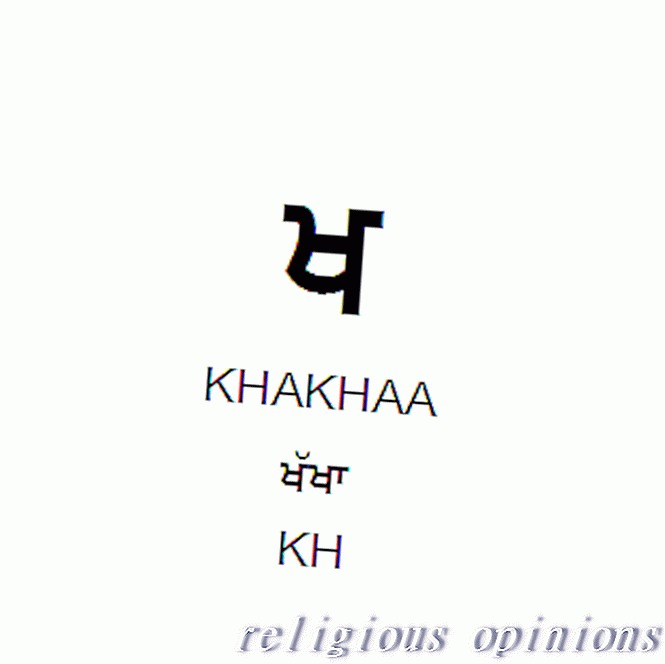 Punjabi Akhar Khakhaa Significância em Sikh Escritura Gurmukhi Script Khakhaa. Foto [S Khalsa]
Punjabi Akhar Khakhaa Significância em Sikh Escritura Gurmukhi Script Khakhaa. Foto [S Khalsa] Khakhaa é uma consoante do alfabeto Gurmukhi.
KH - Gurmukhi Khakhaa - Guia de pronúncias
Khakhaa é uma consoante da escrita Gurmukhi de Gurbani e idêntica ao alfabeto Punjabi.
Khakhaa tem o som de Kh e é pronunciado como ka-kaw (caw), com ênfase na segunda sílaba. Deve haver uma nuvem de ar quando a mão é segurada na frente dos lábios. A grafia romanizada de Khakhaa é fonética e pode aparecer também como Khakha . As grafias podem diferir ligeiramente em Gurmukhi original, bem como em traduções romanizadas e inglesas de Gurbani.
Significado de Khakhaa nas Escrituras Sikhs
A escritura sique inclui a forma acróstica do verso poético que caracteriza Khakhaa do alfabeto Gurmukhi e aparece em várias seleções em todo o Guru Granth Sahib.
Guru Nanak, o primeiro guru Sikh, surpreendeu seus instrutores quando, quando menino, dava uma lição de casa na escola para escrever o alfabeto, a criança respondia com um acróstico espiritual:
" Khakhai khundhkaar saah kar aalam khareed jin kharach deeaa ||
KHAKHA: O criador mundial do sopro e do tempo extrai a receita da falta de subsistência de alguém. "SGGS || 432
Outros versos acrósticos em Gurbani incluem vários autores do Guru Granth Sahib:
Composições poéticas em louvor do Todo-poderoso pelo Quinto Guru Arjun Dev
" Khakhaa khoonaa kachh nehee tis sanmrath kai paa-eh ||
KHAKHA: O Senhor Onipotente não tem nada. "SGGS || 253
" Khakhaa kharaa saraahou taahoo ||
KHAKHA: Genuinamente louve-o. "SGGS | 260
Insights poéticos para a alma por Bhagat Kabir
" Khakhaa i-ahai khorr man aavaa ||
KHAKHA: A alma entra na caverna do corpo. "SGGS || 340
" khakhaa khoj parai jo koee ||
KHAKHA: Raros procurando buscá-lo. "SGGS || 342
" Khakhaa khirat khapat ga-e kaetae ||
KHAKHA: Muitos que perderam e arruinaram suas vidas perecem. "SGGS || 342
Gurmukhi Alfabeto Gagaa de Gurbani Ilustrado com Pronúncia
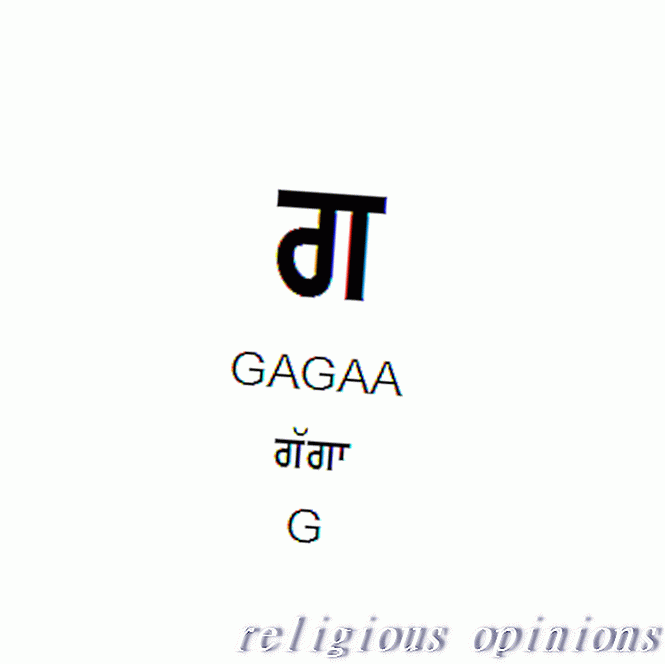 Punjabi Akhar Gagaa Significância na Escritura Sikh Gurmukhi Script Gagaa. Foto [S Khalsa]
Punjabi Akhar Gagaa Significância na Escritura Sikh Gurmukhi Script Gagaa. Foto [S Khalsa] Gagaa é uma consoante do alfabeto Gurmukhi akhar.
G - Guia de Pronúncia Gurmukhi Gagaa
Gagaa é uma consoante da escrita gurmukhi akhar de Gurbani e idêntica ao alfabeto do paine Punjabi.
Gagaa é pronunciada como ga-gaw, com ênfase na segunda sílaba. Não deve haver sopro de ar quando a mão é segurada na frente dos lábios. A grafia romanizada de Gagaa é fonética e pode aparecer também como Gagga . As grafias podem diferir ligeiramente em Gurmukhi original, bem como em traduções romanizadas e inglesas de Gurbani.
Significado de Gagaa na Escritura Sikh
A escritura sikh inclui a forma acróstica do verso poético e aparece em todo o 'Guru Granth Sahib com significados insights espirituais apresentando o Gagaa do alfabeto Gurmukhi .
O guru Nanak, primeiro dos gurus siques, surpreendeu seus instrutores quando, quando menino, dava uma lição de casa na escola para escrever o alfabeto, a criança respondia com um acróstico espiritual:
" Gagai goe gaae jin chode de galee gobid garab bha-iiaa ||
GAGGA: Quem renuncia a cantar canções do Senhor Universal, torna-se arrogante na fala. "SGGS || 432
Outros versos acrósticos em Gurbani incluem:
O quinto Guru Arjun Dev elogia os efeitos da meditação:
" Gagaa arma gobid ravhou saas saas jap neet ||
GAGGA: Pronuncie os louvores gloriosos do Mestre do Mundo, com cada respiração meditando Nele sempre. "SGGS || 254
Verso de Bhagat Kabir expõe o Guru Iluminador:
" Gagaa gur kae bachan pachhaanaa ||
GAGGA: Compreender o enunciado da instrução do iluminista. "SGGS || 340
Terceiro Guru Amar Das pondera a imensidão do Senhor universal.
" Gagai gobid chit kar mooré galee kinai na paa-i-aa ||
Gagga: Pondere o Senhor Universal Ó tolo, por mera conversa ninguém jamais O alcançou. "SGGS || 434
Alfabeto Gurmukhi Ghaghaa de Gurbani Ilustrado com Pronúncia
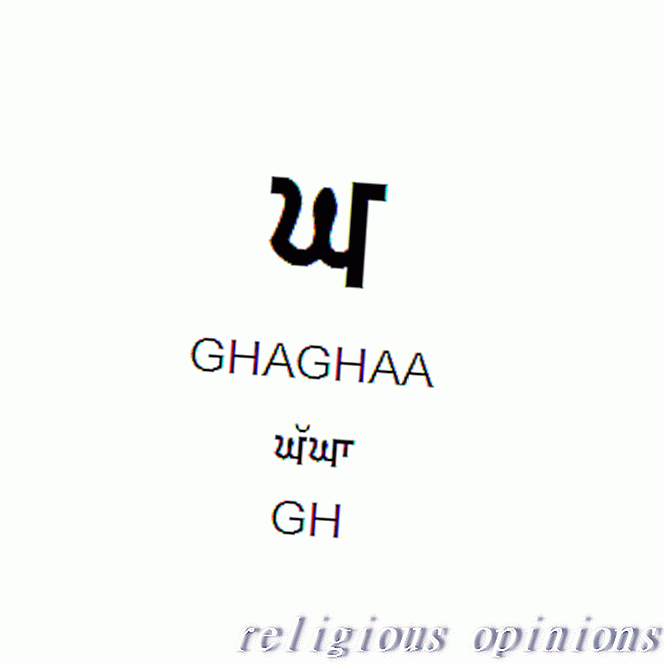 Punjabi Akhar Ghaghaa Significância em Sikh Escritura Gurmukhi Script Ghaaghaa. Foto [S Khalsa]
Punjabi Akhar Ghaghaa Significância em Sikh Escritura Gurmukhi Script Ghaaghaa. Foto [S Khalsa] Ghaghaa é uma consoante do alfabeto Gurmukhi.
Guia de pronúncias de GH - Gurmukhi Ghaghaa
Ghaghaa é uma consoante da escrita Gurmukhi akhar, que é muito semelhante ao alfabeto Punjabi Paintee.
Ghaghaa é pronunciado como gha ghaaw, com ênfase na segunda sílaba. Deve haver uma nuvem de ar quando a mão é segurada na frente dos lábios. A grafia romanizada de Ghaghaa é fonética e também pode aparecer grafada como Ghagha . As grafias podem diferir ligeiramente em Gurmukhi original, bem como em traduções romanizadas e inglesas de Gurbani.
Significado de Ghaghaa nas Escrituras Sikhs
A escritura sique inclui versos apresentando Ghaghaa do alfabeto Gurmukhi por vários autores de Gurbani e aparece em todo o Guru Granth Sahib.
Guru Nanak, o primeiro guru dos siques, surpreendeu seus instrutores quando recebeu uma tarefa na escola para escrever o alfabeto; a criança respondeu com um acróstico espiritual:
" Ghaghai ghaal saevak jaae ghaalai sabad gurao kai laag rehai ||
Prestando serviço ao atendente, mesmo enquanto servindo aos hinos divinos do Enlightener ligado permanece. "SGGS || 432
Outros versos poéticos significativos dos autores do Guru Granth Sahib apresentando Ghagha incluem:
O quinto Guru Arjan Dev enfatiza que existe apenas Deus.
" Ghaghaa ghaalhou maneh eh bin har doosar naa-ele ||
GHAGHA: Coloque em sua mente que não há outro senão o Senhor. "SGGS || 254
Bhagat Kabir diz onde o divino é encontrado.
" Ghaghaa ghatt ghatt nimasai soee ||
GHAGHA: Em todo e qualquer coração Ele habita. "SGGS || 340
O Terceiro Guru Amar Das nos dá a ideia de que, por mais que a alma busque, ela não reconhece os verdadeiros dons e bênçãos.
" Ghaghai ghar ghar fogo toon moorrae dadai daan na tudh la-i-aa || 9 ||
GHAGHA: De porta a porta, você vai implorar o tolo. Dadda: Mas a benção que você não aceita. "SGGS || 423
Gurmukhi Alfabeto Ngangaa de Gurbani Ilustrado Com Pronúncia
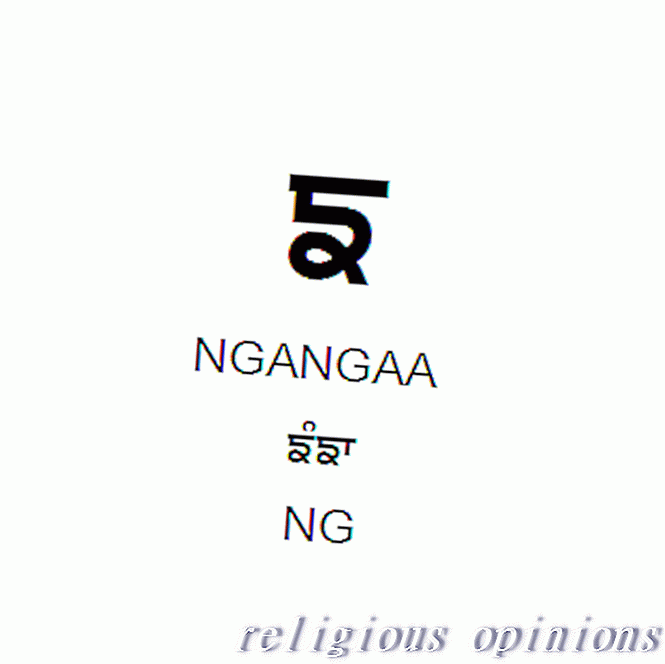 Punjabi Akhar Ngangaa Significância em Sikh Escritura Gurmukhi Script Ngangaa. Foto [S Khalsa]
Punjabi Akhar Ngangaa Significância em Sikh Escritura Gurmukhi Script Ngangaa. Foto [S Khalsa] Ngangaa é uma consoante do alfabeto Gurmukhi.
NG - Gurmukhi Ngangaa guia de pronúncia
Ngangaa é uma consoante do roteiro akhar de Gurmukhi de Gurbani e idêntica ao alfabeto do paine Punjabi.
Ngangaa tem o som de NG e é pronunciado com ênfase na segunda sílaba. A grafia romanizada de Ngangaa é fonética e pode aparecer também como Nganga ou Nganngaa . As grafias podem diferir ligeiramente em Gurmukhi original, bem como em traduções romanizadas e inglesas de Gurbani.
Significado de Ngangaa nas Escrituras Sikhs
A escritura sikh em todo o Guru Granth Sahib inclui composições acrósticas alfabéticas na forma de versos poéticos com insights de significado espiritual.
Guru Nanak Dev como um menino surpreendeu seu tutor quando instruído a escrever o alfabeto, ele respondeu com um acróstico sobre o assunto do estudioso espiritual:
" Ngan-ngai ngiaan boojhai jaae koee parriaa panddit soee ||
NGANGA: Um com uma compreensão do conhecimento espiritual torna-se um erudito religioso. "SGGS || 432
Outros versos acrósticos signifigantes que apresentam Ngangaa pelos autores de Gurbani bani incluem:
O quinto Guru Arjund Dev explica os estudiosos da sabedoria espiritual e a armadilha do mundo material nessas linhas.
" Ngan-ngaa ngiaan nehee mukh baato ||
NGANGA: A sabedoria divina não é obtida meramente de boca em boca. "Guru Arjun SGGS || 251
" Ngan-ngaa khatt saastra enxada ngiaataa ||
NGANGA: Um pode ser um estudioso das seis escolas de uma filosofia. "Guru Arjun SGGS || 253
" Ngan-ngaa ngraasai kaal teh jo saakat prabh interessado ||
NGANGA: A morte se apega àquele que é ordenado por Deus para ser um adorador do mundo material. "SGGS || 2534
Bhagat Kabir aconselha sabedoria inescrutável em seu verso:
" Ngan-ngaa nigreh anaeú kar nirvaaro sandaeh ||
NGANGA: Empregue auto-restrição, ame o divino e rejeite a dúvida. "SGGS || 340
Alfabeto Gurmukhi de Chachaa Gurbani Ilustrado com Pronúncia
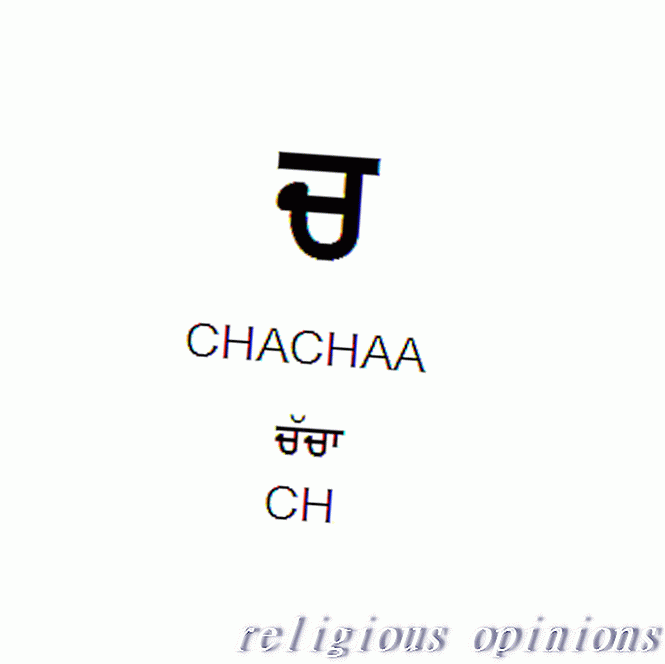 Punjabi Akhar Chachaa Significância na Escritura Sikh Gurmukhi Script Chachaa. Foto [S Khalsa]
Punjabi Akhar Chachaa Significância na Escritura Sikh Gurmukhi Script Chachaa. Foto [S Khalsa] Chachaa é uma consoante do alfabeto Gurmukhi.
Guia de pronúncias Ch - Gurmukhi Chachaa
Chachaa é uma consoante do roteiro de Gurmukhi akhar de Gurbani que é idêntico ao alfabeto do paine Punjabi.
Chachaa é um símbolo para CH e é pronunciado com a língua logo atrás dos dentes superiores como ch in coceira com ênfase na segunda sílaba. Chachaa é fonético e também pode aparecer escrito como Chacha . As grafias Phonetci podem diferir ligeiramente na gramática Gurmukhi original, bem como nas traduções romanizadas e inglesas de Gurbani.
Significado de Chachaa na Escritura Sikh
Em toda a escritura do Guru Granth Sahib, a forma acróstica do verso poético expõe o significado espiritual do alfabeto Gurmukhi.
O primeiro guru Nanak Dev impressionou seus tutores quando, quando jovem, recebia uma tarefa para escrever o alfabeto, a criança respondeu com um acróstico espiritual sobre o assunto dos textos védicos:
" Chachai chaar ved jin saajae chaarae khaanee chaar jugaa ||
CHACHA: Ele é a fonte criativa das quatro escrituras védicas, quatro métodos de procriação e as quatro eras. "SGGS || 432
" Bas jal nit na vasat alee-al maer * cha-chaa * arma rae ||
(Ó sapo tolo) você mora sempre na água (onde o lírio floresce), mas a abelha que não mora lá * * intoxica a fome com a fragrância (do lírio) de longe. "SGGS || 990
Outros versículos alphbetcal signifigant caracterizando Chacha por vários autores de Guru Granth Sahib incluem:
Quinto Guru Arjun Dev em seu verso descrevendo seu relacionamento com o divino.
" Chachaa charan kamal gur laagaa ||
CHACHA: Aos pés de lótus do Iluminador estou ligado. "SGGS || 254
Bhagat Kabir cuja poesia é descritiva da arte divina.
" Chachaa rachit chitra hai bhaaree ||
CHACHA: Ele pintou o grande retrato que é o mundo ". SGGS || 340
Gurmukhi Alfabeto Chhachhaa de Gurbani Ilustrado com Pronúncia
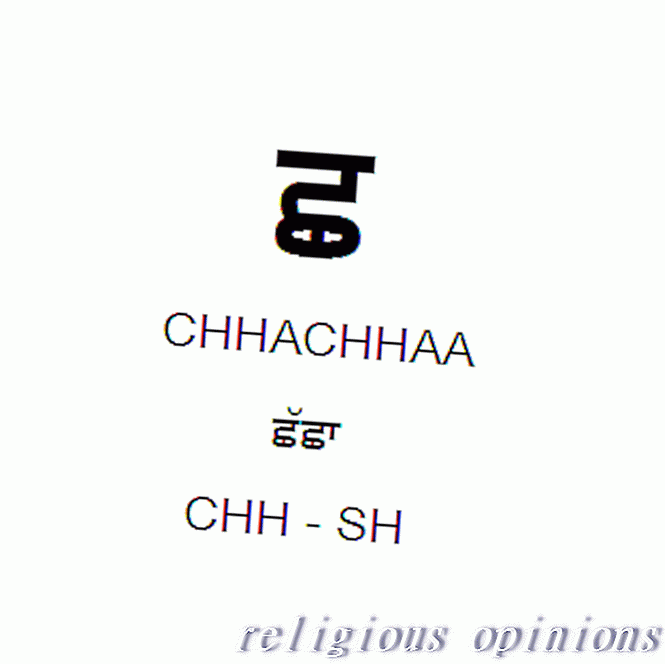 Punjabi Akhar Chhachhaa Significância na Escritura Sikh Gurmukhi Script Chhachhaa. Foto [S Khalsa]
Punjabi Akhar Chhachhaa Significância na Escritura Sikh Gurmukhi Script Chhachhaa. Foto [S Khalsa] Chhachhaa é uma consoante do alfabeto Gurmukhi.
CHH (SH) - Guia de Pronúncia de Gurmukhi Chhachhaa
Chhachhaa é uma consoante do alfabeto Gurmukhi akhar de Gurbani e idêntica ao alfabeto do paine Punjabi.
Chhachhaa tem o som de C no oceano e é pronunciado com ênfase na segunda sílaba. A grafia romanizada de Chhachhaa é fonética e pode aparecer como Chhachha, Shhassha e Shhasshaa . As grafias podem diferir ligeiramente em Gurmukhi original, bem como em traduções romanizadas e inglesas de Gurbani.
Significado de Chhachhaa nas Escrituras Sikhs
Em toda a escritura de 'Guru Granth Sahib podem ser encontrados versos poéticos caracterizando o significado espiritual do alfabeto Gurmukhi akhar Chhachhaa :
Guru Nanak, primeiro dos gurus siques, surpreendeu seus instrutores com um acróstico alfabético sobre a ignorância espontânea:
" Chhachhai chhaa-i-aa vária sabh antar tera keeaa bharam hoaa ||
CHHACHHA: A difusão da ignorância espiritual está dentro de todos os que duvidam do que você faz. "SGGS || 433
Outros acrósticos alfabéticos em Gurbani incluem versos de vários autores do Guru Granth Sahib:
O quinto Guru Arjun Dev relata a humildade ideal da alma em seus versos acrósticos:
" Chhashhaa Chhoharae daas tumaarae ||
CHHACHHA: Essa criança é sua serva. "SGGS || 254
" Chhachhaa chhaar quente tere santaa ||
CHHACHHA: Que eu seja o pó sob os teus santos. "SGGS || 254
Bhagat Kabir pondera a presença de Deus com seu verso:
" Chhashhaa ihai chhatrapat paasaa ||
CHHACHHA: O honorável Senhor Mestre está presente. "SGGS || 340
" Chhachhai chheejeh ahnis moorrae kio chhootteh atolamento paakarri-aa || 2 ||
Terceiro Guru Amar Das questiona o valor das buscas mundanas em seu verso:
CHHACHHA: Você está desgastando a noite e o dia Ó tolo, como você vai encontrar liberação sendo segura nas garras da morte? "|| 2 || SGGS || 434
13 de 36Gurmukhi Alfabeto Jajaa de Gurbani Ilustrado Com Pronúncia
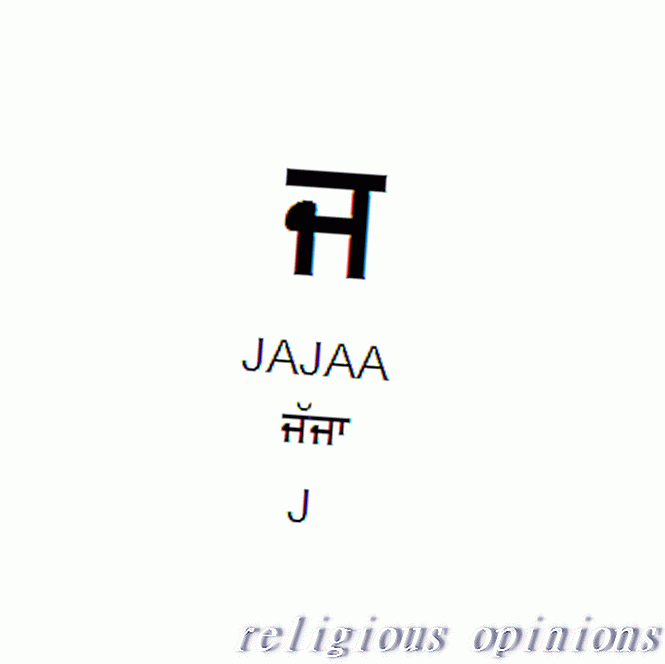 Punjabi Akhar Jajaa Significância na Escritura Sikh Gurmukhi Script Jajaa. Foto [S Khalsa]
Punjabi Akhar Jajaa Significância na Escritura Sikh Gurmukhi Script Jajaa. Foto [S Khalsa] Jajaa é uma consoante do alfabeto Gurmukhi.
J - Guia de Pronúncia de Gurmukhi Jajaa
Jajaa é uma consoante do roteiro de Gurmukhi akhar de 35 caracteres de Gurbani que é idêntico ao alfabeto do paine Punjabi.
Jajaa tem o som de J e é pronunciado com ênfase na segunda sílaba como ja-jaw. A grafia romanizada de Jajaa é fonética e pode aparecer também como Jajja . As grafias podem diferir ligeiramente em Gurmukhi original, bem como nas traduções romanizadas e inglesas de Gurbani.
Significado de Jajaa na Escritura Sikh
A escritura Sikh Guru Granth Sahib inclui uma forma acróstica de verso poético escrito pelo primeiro Primeiro Guru Nanak Dev como um jovem estudante quando instruído a escrever o alfabeto:
Jajai jaan mangat janeiro jaachai lakh chouraaseeh bheekh bhaviaa ||
JAJJA: Este ser humilde implora por sabedoria ter vagado implorando por oitenta e quatro lakhs (8.4 milhões) existências. "SGGS || 433
Outros versos acrósticos em Gurbani incluem versos de significação espiritual, destacando Jajaa por vários outros autores do Guru Granth Sahib, incluindo:
" Jajaa jaanai ho kashh hooaa ||
JAJJA: O Ego centrado acredita que ele se tornou algo. "SGGS || 255 por Fifth Guru Arjan Dev
" Jajaa jo tan jeevat jaraavai ||
JAJJA: Quem queima o corpo enquanto ainda vivo. "SGGS || 340 por Bhagat Kabir
" Jajai joh hir la-ee teree moorrae e gaiaa pachhutaavehgaa ||
JAJJA: Você foi roubado de sua luz divina Ó tolo, arrependido no final você partirá com arrependimento. "SGGS || 434 pelo Terceiro Guru Amar Das
14 de 36Gurmukhi Alfabeto Jhajhaa de Gurbani Ilustrado Com Pronúncia
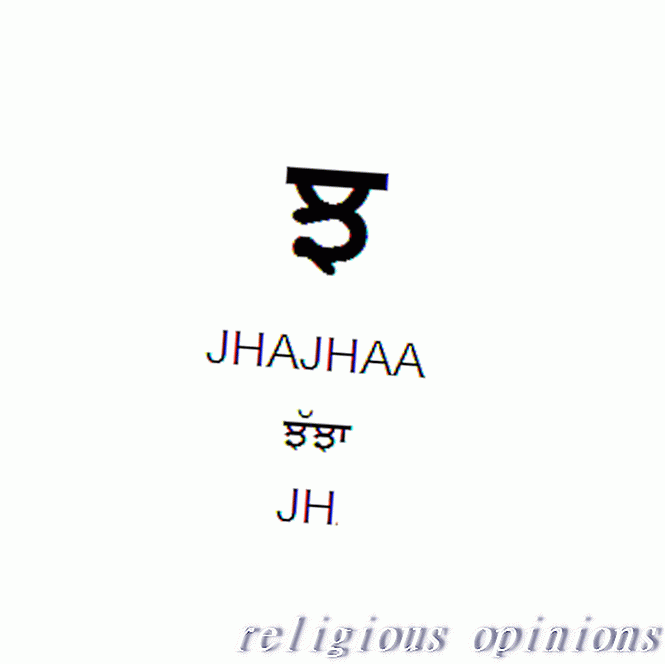 Punjabi Akhar Jhajhaa Significância na Escritura Sikh Gurmukhi Script Jhajhaa. Foto [S Khalsa]
Punjabi Akhar Jhajhaa Significância na Escritura Sikh Gurmukhi Script Jhajhaa. Foto [S Khalsa] Jhajhaa é uma consoante do alfabeto Gurmukhi.
Guia de pronúncias de Jh - Gurmukhi Jhajhaa
Jhajhaa é uma consoante da escrita Gurmukhi e idêntica ao alfabeto Punjabi.
Jhajhaa tem o som de Jh semelhante a J como em Jacques, Zs como em Zsa Zsa, ou X como em Xenia e é pronunciado como Jh-jhaaw ou Zsa-Zsaa, com ênfase na segunda sílaba. Deve haver uma nuvem de ar quando a mão é segurada na frente dos lábios. A grafia romanizada de Jhajhaa é fonética e pode aparecer também como Jhajha . As grafias podem diferir ligeiramente em Gurmukhi original, bem como em traduções romanizadas e inglesas de Gurbani.
Significado de Jhajhaain Sikh Scripture
A escritura sikh inclui a forma acróstica do verso poético apresentando Jhajhaa do alfabeto Gurmukhi e aparece em todo o Guru Granth Sahib.
Como um jovem estudante, Guru Nanak Devi escreveu um verso orientado espiritualmente afirmando a natureza abundante do Divino:
" Jhajhai jhoor maru kiaa pranee jo kichh daennaa so dae rehiaa ||
JHAJHA: Ó mortal, por que você morre de ansiedade? Tudo o que o Senhor dá, Ele concede continuamente. "SGGS || 433
Os versos acrósticos em Gurbani por outros autores do Guru Granth Sahib incluem:
" Jhajhaa jhooran mittai tumaaro ||
JHAJHA: Suas tristezas terminarão. " SGGS || 255 Guru Arjan Dev
" Jhajhaa ourajh surajh nehee jaanaa ||
JHAJHA: Você está enredado no mundo e não sabe como se desvencilhar. " SGGS || 340 Bhagat Kabir
" Jhajhai kadhae não jhooreh moorrae satgur kaa oupadaes sun toon vikhaa ||
JHAJHA: Você pode nunca precisar se arrepender, ó tolo, se você tivesse escutado a instrução do Verdadeiro Iluminador por um instante. " SGGS || 435 Guru Amar Das
Gurmukhi Alfabeto Njanjaa de Gurbani Ilustrado com Pronúncia
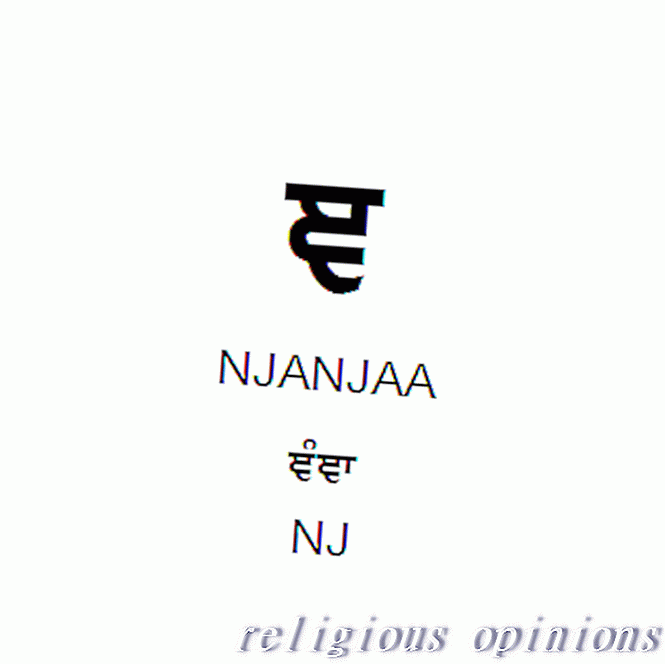 Punjabi Akhar Njanjaa Significância na Escritura Sikh Gurmukhi Script Njanjaa. Foto [S Khalsa]
Punjabi Akhar Njanjaa Significância na Escritura Sikh Gurmukhi Script Njanjaa. Foto [S Khalsa] Njanjaa é uma consoante do alfabeto Gurmukhi.
Nj - Gurmukhi Njanjaa guia de pronúncia
Njanjaa é uma consoante da escrita Gurmukhi que é idêntica ao alfabeto Punjabi.
Njanjaa é dito com a língua pressionada no céu da boca atrás dos dentes superiores, com ênfase na segunda sílaba. Njanjaa é fonético, Nj também pode ser escrito como Ny ou mesmo Ni e é pronunciado como Enya, cebola ou Califórnia ao invés de desfrutar ou motor. Njanjaa também pode aparecer escrito como Nyanya, pois as grafias diferem ligeiramente ao longo dos textos Gurmukhi originais, assim como as traduções romanizadas e inglesas de Gurbani.
Significado de Njanjaa na Escritura Sikh
A escritura sikh inclui formas acrósticas de verso poético com Njanjaa .
Mostrando uma visão espiritual enquanto ainda era um menino, Guru Nanak Dev primeiro dos gurus Sikh escreveu:
" Njannjai nadar karae jaa daekhaa doojaa koee naahee ||
Concedendo a visão de seu olhar gracioso, não vejo outro além dele. "SGGS || 433
Outros shabads acrósticos significativos de Gurbani com Njanjaa incluem:
" Njannjaa njaanhu drirr sehee binas jaat eh hae-et ||
NYANYA: Saiba como perfeitamente correto, que o amor mundano terminará. "Quinto Guru Arjun Dev SGGS || 255
" Njannjaa nikatt ju ghatt rehio porta kehaa taj jaa-e ||
NYANYA: Ele mora perto do seu coração, por que ir longe para procurá-lo? "SGGS || 340 Bhagat Kabir
Gurmukhi Script Tainkaa de Gurbani ilustrado com pronúncia
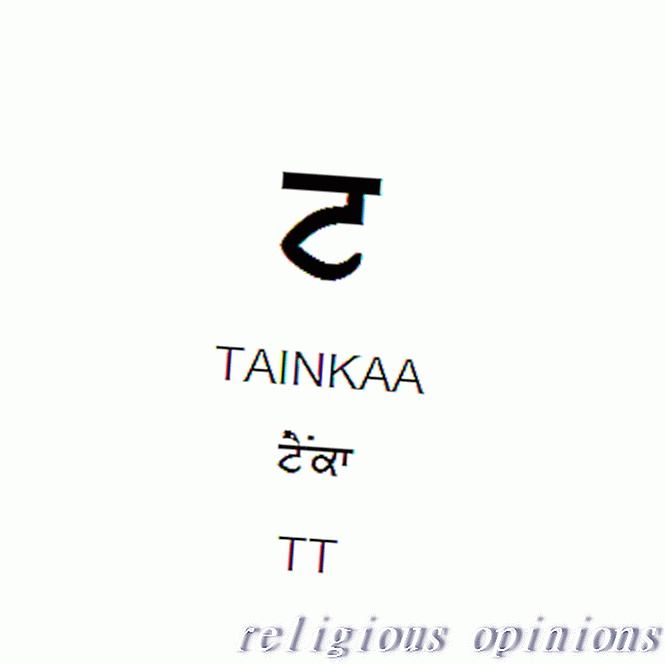 Punjabi Akhar Tainkaa de Gurbani Ilustrado Gurmukhi Script Tainkaa. Foto [S Khalsa]
Punjabi Akhar Tainkaa de Gurbani Ilustrado Gurmukhi Script Tainkaa. Foto [S Khalsa] Tainkaa é uma consoante do alfabeto Gurmukhi.
TT - Guia de Pronúncia de Gurmukhi Tainka
Tainkaa é uma consoante da escrita Gurmukhi que é idêntica ao alfabeto Punjabi.
Tainkaa soa como tank-aw, representa um T duro como no reboque, pode ser representado por um TT duplo e pronunciado com a língua enrolada para trás para tocar o céu da boca. A grafia romanizada de Tainkaa é fonética e também pode aparecer como Tanka, Tatta ou Ttatta, já que as grafias podem diferir ligeiramente nos textos Gurmukhi originais, bem como nas traduções romanizadas e inglesas de Gurbani.
Significância de Tainka na Escritura Sikh
A escritura sique inclui insights espirituais escritos sob a forma de poemas acrósticos pelo primeiro guru Nanak como estudante:
Ttattai ttanch karuh kiaa praannee gharree ke mueht ke ootth chalnaa ||
TATTA: Por que você pratica a hipocrisia O Mortal? Em um momento você deve se levantar e em um instante partir. "SGGS || 433
Outro verso acróstico sagrado com Tatta inclui isto por Bhagat Kabir:
" Ttattaa bikatt ghaatt ghatt maahee ||
TATTA: O caminho difícil para Deus está no caminho do coração e da mente. "SGGS || 341
Gurmukhi Script Tthatthhaa de Gurbani ilustrado com pronúncia
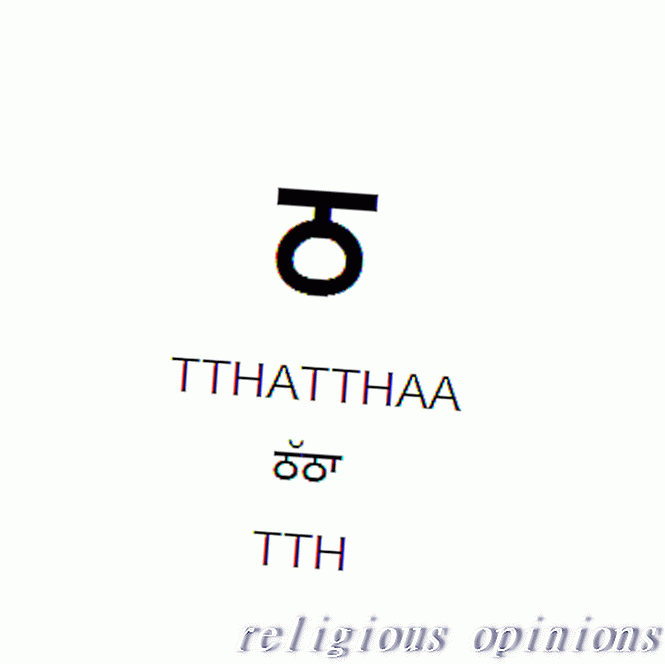 Punjabi Akhar Tthatthhaa Significância na Escritura Sikh Escrita Gurmukhi TThatthaa. Foto [S Khalsa]
Punjabi Akhar Tthatthhaa Significância na Escritura Sikh Escrita Gurmukhi TThatthaa. Foto [S Khalsa] Thathatha é uma consoante do alfabeto Gurmukhi.
TTH - Gurmukhi Tthatthaa - Guia de pronúncias
Tthatthaa é uma consoante do Akurukhi Akhar que é idêntica ao alfabeto Punjabi paintee.
Tthatthaa tem o som de Th e é pronunciado como tha-thaaw com ênfase na segunda sílaba. A língua está enrolada para trás para tocar o céu da boca e deve haver uma lufada de ar quando a mão é segurada na frente dos lábios. A grafia romanizada de Tthatthaa é fonética e também pode aparecer como Tthattha, Thhathaa ou outras variações. As grafias fonéticas originais de Gurmukhi podem diferir visualmente, assim como as traduções romanizadas e inglesas de Gurbani.
Significado de Thathatha na Escritura Sikh
Formas acrósticas de versos poéticos espiritualmente significativos com consoantes do alfabeto Gurmukhi aparecem em toda a escritura do Guru Granth Sahib. Quando menino em Nanakana Sahib, Guru Nanak Dev, o reformador escreveu:
Tthhatthhai thhaadhh vartee tin antar har charnee jinh kaa chit laagaa ||
TTHHATTHA: A paz permeia o coração daqueles cuja mente está ligada aos Pés de Lótus do Senhor. "SGGS || 433
Outros versos acrósticos que incluem Tthatthaa por autores de Gurbani incluem:
" Tthhatthaa manooaa thhaaheh naahee ||
TTHHATTHA: Os sentimentos que eles não ferem. "SGGS || 256 Quinto Guru Arjun Dev
" Tthhatthhaa ehai porta thhag neeraa ||
TTHHATTHA: Mantenha-se longe desta miragem. "SGGS 341 Bhagat Kabir
Gurmukhi Alfabeto Ddaddaa de Gurbani Ilustrado com Pronúncia
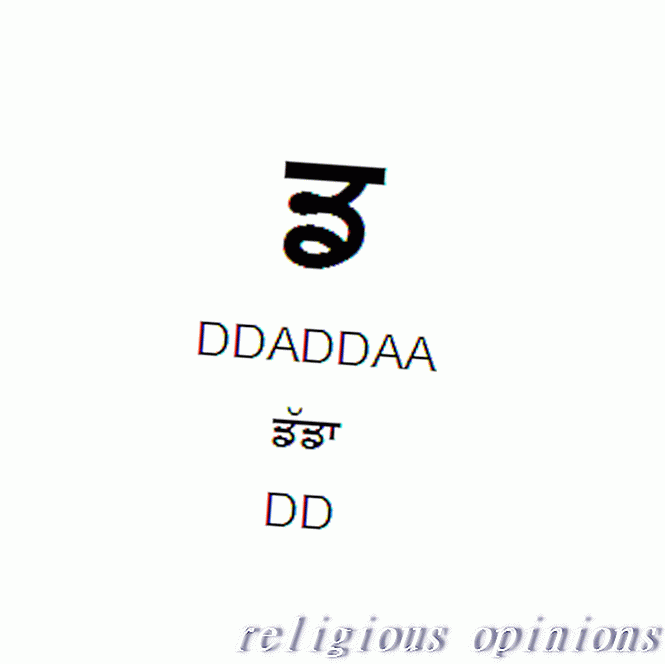 Punjabi Akhar Ddaddaa Significância na Escritura Sikh Gurmukhi Script Ddaddaa. Foto [S Khalsa]
Punjabi Akhar Ddaddaa Significância na Escritura Sikh Gurmukhi Script Ddaddaa. Foto [S Khalsa] Ddaddaa é uma consoante do alfabeto Gurmukhi.
DD - Gurmukhi Ddaddaa guia de pronúncia
Ddaddaa é uma consoante do recurso de script Gurmukhi em Gurbani e é idêntica ao alfabeto Punjabi.
Ddaddaa é representado por DD e é pronunciado Da-daaw, com ênfase na segunda sílaba. A língua está enrolada de volta para tocar o céu da boca atrás da crista da gengiva. O som é semelhante ao DD duplo no papai ou no D no sapo ou no médico. A grafia romanizada de Ddaddaa é fonética e também pode aparecer simplesmente como Dadda . As grafias também podem diferir ligeiramente em Gurmukhi original, bem como em traduções romanizadas e inglesas de Gurbani.
Significado de Ddaddaa nas Escrituras Sikhs
Diversos shabads do Guru Granth Sahib apresentam Ddaddaa em uma forma acróstica de verso poético tendo signifi- cância espiritual.
Guru Nanak, primeiro dos gurus siques, começou a escrever hinos de mérito espiritual ainda menino:
" Ddaddai ddanph karhu kiaa praannee jo kichh hoaa su sabh chalnaa ||
DDADDA: Por que você faz esses shows ostensivos, ó mortal? O que quer que exista, tudo passará. "SGGS || 433
Outros versos acrósticos pelos autores de Gurbani onde Ddaddaa aprova incluem:
" Ddaddaa ddaeraa ehu nehee jeh dderaa o jaan ||
DDADDA: Esta morada não é a sua verdadeira morada que você deve conhecer. "SGGS || 256 Quinto Guru Arjan Dev
" Ddaddaa ddar oupajae ddar jaaee ||
DDADDA: Quando o temor de Deus é realizado, outros medos partem. "SGGS || 341 Bhagat Kabir
Alfabeto Gurmukhi Dhhadhhaa de Gurbani Ilustrado com Pronúncia
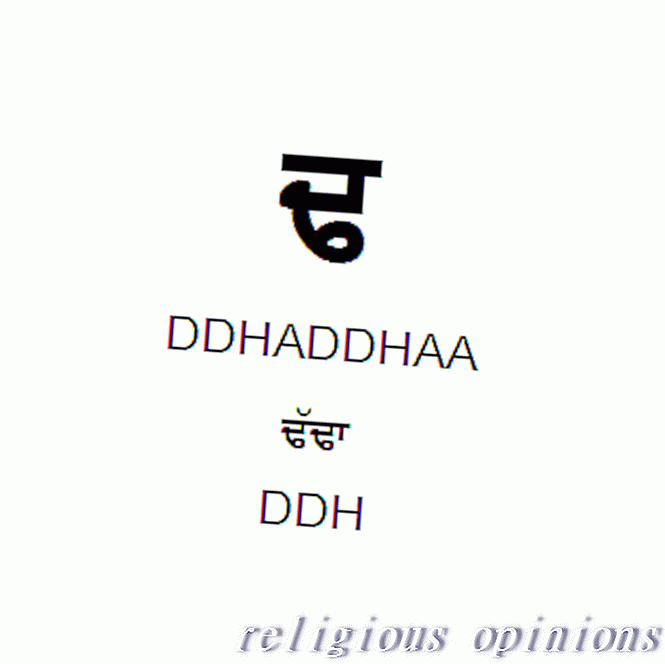 Punjabi Akhar Dhhhaddhhaa Significance in Sikh Scripture Gurmukhi Script DDhaddhaa. Foto [S Khalsa]
Punjabi Akhar Dhhhaddhhaa Significance in Sikh Scripture Gurmukhi Script DDhaddhaa. Foto [S Khalsa] Ddhaddhaa is a consonant of the Gurmukhi alphabet.
Dhh - Gurmukhi Dhhadhhaa Pronunciation Guide
Dhhadhhaa is a consonant of the Gurmukhi script featured in the hymns of Gurbani, and is identical to the Punjabi alphabet.
Dhhadhhaa has the sound of Dh and is pronounced as dha-dhaaw, with emphasis on the second syllable. The tongue is curled back to touch the roof of the mouth behind the gum ridge. There should be a puff of air when when the hand is held in front of the lips. The Romanized spelling of Dhhadhhaa is phonetic and may also appear spelled as Ddhaddhaa or even variations of Dtadtaa . Spellings also may differ slightly in original Gurmukhi as well as Romanized and English translations of Gurbani.
Significance of Dhhadhhaa in Sikh Scripture
The acrostic form of poetry featuring Dhhadhhaa of the Gurmukhi alphabet appears in several of the Guru Granth Sahib hymns.
While still a child, First Guru Nanak stressed the spiritual signifigance of poetic composition when he wrote:
" Dhhadhhai dhhaa-eh ousaarai aapae jio tis bhaavai tivai karae ||
DHHADHHA: The Lord himself establishes and disestablishes, as it pleases Him so does He do." SGGS||432
Other such acrostic verses in Guru Granth Sahib include:
" Dhhadhhaa dhhoodhhat keh phirhu dhhoodhhan e-aa man maa-eh || ||
DHHADHHA: Where do you wander about to go searching? Search instead within your own mind." Fifth Guru Arjan Dev SGGS||256
" Dhhadhhaa dhhig dhhoodhheh kat aanaa ||
DHHADHHA: Why do you search for him elsewhere in every other direction? SGGS||341 Bhagat Kabir
Gurmukhi Alphabet Nhaanhaa of Gurbani Illustrated With Pronunciation
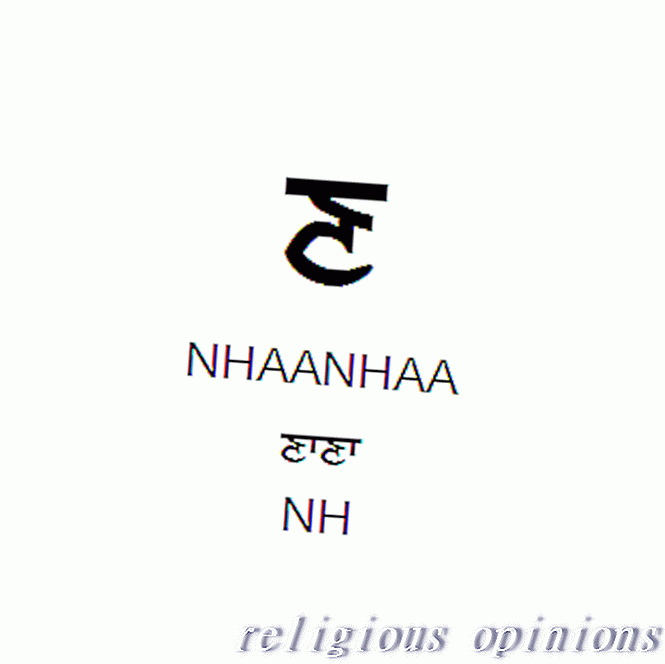 Punjabi Akhar Nhaanhaa Significance in Sikh Scripture Gurmukhi Script Nhaanhaa. Foto [S Khalsa]
Punjabi Akhar Nhaanhaa Significance in Sikh Scripture Gurmukhi Script Nhaanhaa. Foto [S Khalsa] Nhaanhaa of the Gurmukhi alphabet.
Nh - Gurmukhi Nhaanhaa Pronunciation Guide
Nhaanhaa is a consonant of the 35 Gurmukhi akhar of Gurbani and is identical to the Punjabi alphabet.
Nhaanhaa is represented by Nh or a double NN has the sound of N as in burn. Nhaanhaa is said with emphasis equally on both syllables as in Na-na, and is pronounced with the tongue curled back to touch the roof of the mouth so that when spoken there is a slight puff of air when the hand is held in front of the lips. The Romanized spelling of Nhaanhaa is phonetic and may also appear spelled as Nanna . Spellings may also differ slightly in original Gurmukhi as well as Romanized and English translations of Gurbani.
Significance of Nhaanhaa in Sikh Scripture
An acrostic form of poetic verse written by First Guru Nanak as a young boy when given a homework assignment in school by his teacher to write the alphabet expresses the spritual acheivement of conquering ego:
" Naanai ravat rehai ghatt antar har gun gaavai soee ||
NANNA: One whose inner being is filled with the Lord, sings His glorious praise." SGGS||433
Other acrostic verses featuring Nhaanhaa composed by various authors of Gurbani include:
" Naanaa ran tae seejhee-ai aatam jeetai koe ||
NANNA: One who conquers their own being, wins the battle of life." SGGS||256 Fifth Guru Arjan Dev
" Naanaa ran rootou nar nehee karai ||
NANNA: The warrior who fights on the battle-field should keep up and press on." SGGS||340 Bhagat Kabir
Gurmukhi Alphabet Tataa of Gurbani Illustrated With Pronunciation
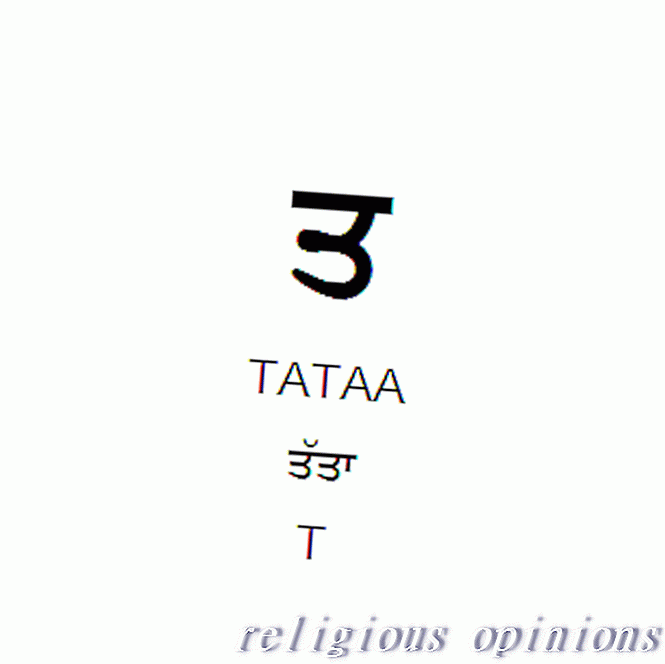 Punjabi Akhar Tataa Significance in Sikh Scripture Gurmukhi Script Tataa. Foto [S Khalsa]
Punjabi Akhar Tataa Significance in Sikh Scripture Gurmukhi Script Tataa. Foto [S Khalsa] Tataa is a consonant of the Gurmukhi alphabet.
T - Gurmukhi Tataa Pronunciation Guide
Tataa is a consonant of the 35 Gurmukhi akhar of Gurbani and is identical to the Punjabi alphabet.
Tataa represents the sound of T sounds and is said like ta-taw, with emphasis on the second syllable, and is pronounced with the tongue pressed against the back of the upper teeth. No air is felt when the hand is held in front of the lips. The Romanized spelling of Tataa is phonetic and may also appear spelled as Tatta . Spellings may differ slightly in original Gurmukhi as well as Romanized and English translations of Gurbani.
Significance of Tataa in Sikh Scripture
The scripture of Guru Granth Sahib includes an acrostic form of poetic verse of spritual signifigance written by First Guru Nanak as a young boy:
" Tatai taaroo bhavajal hoaa taa kaa ant na paa-i-aa ||
TATTA: So deep is the terrible world-ocean, its limits cannot be found." SGGS||433
Other acrostic verses of spirtual signifigance featuring Tataa written by the authors of Gurbabi include:
" Tataa taa sio preet kar gun nidh gobid ra-ae ||
TATTA: Enshrine love for that Treasure of Excellence who is the Universal Sovereign Lord." SGGS||256 Fifth Guru Arjan Dev
" Tataa atar tario-oo neh jaa-ee ||
TATTA: The treacherous world-ocean cannot be crossed over." SGGS||341 Bhagat Kabir
Gurmukhi Thathaa of Gurbani Alphabet Illustrated With Pronunciation
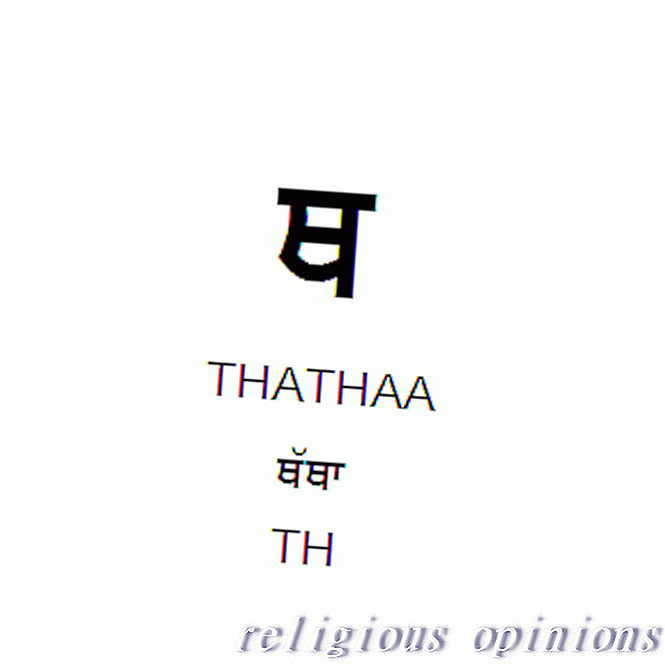 Punjabi Akhar Thathaa Significance in Sikh Scripture Gurmukhi Script Thathaa. Foto [S Khalsa]
Punjabi Akhar Thathaa Significance in Sikh Scripture Gurmukhi Script Thathaa. Foto [S Khalsa] Thathaa is a consonant of the Gurmukhi alphabet.
TH - Gurmukhi Thathaa Pronunciation Guide
Thathaa is a consonant of the 35 Gurmukhi akhar and is identical to the Punjabi paintee alphabet.
Thathaa represents the sound of TH as in teeth, is said like Tha-thaw with emphasis on the second syllable, and is pronounced with the tongue pressed behind the upper teeth so that a puff of air is felt when the hand is held in front of the lips. The Romanized spelling of Thathaa is phonetic and may also appear spelled as Thattha . Spellings also may differ slightly in original Gurmukhi as well as Romanized and English translations of Gurbani.
Significance of Thathaa in Sikh Scripture
As a young boy Guru Nanak surpised his teachers when he wrote a form of acrostic poetry with profound spirtual signifigance:
" Thathai thaan thaanntar so-ee jaa kaa kee-aa sabh ho-aa ||
THATHA: In all the places and interspaces is He, everything which exists is His doing." SGGS||433
Other signifigant acrostic verses using Thathaa composed by the authors of Guru Granth Sahib include:
" Thathaa thir ko-o-oo nehee kaa-e pasaarhu paav ||
THATHA: Nothing is permanent, why do you stretch out your feet?" SGGS||257 Guru Arjun Dev
" Thathaa athaah thaah nehee paavaa ||
THATHA: He is Unfathomable, His depths cannot be explored." SGGS||342 Bhagat Kabir
Gurmukhi Alphabet Dadaa of Gurbani Illustrated With Pronunciation
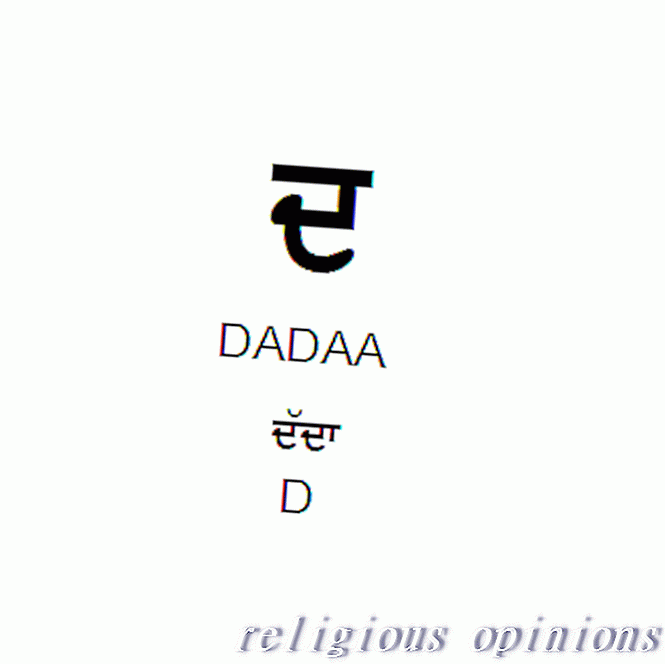 Punjabi Akhar Dadaa Significance in Sikh Scripture Gurmukhi Script Dadaa. Foto [S Khalsa]
Punjabi Akhar Dadaa Significance in Sikh Scripture Gurmukhi Script Dadaa. Foto [S Khalsa] Dadaa is a consonant of the Gurmukhi alphabet.
D - Gurmukhi Dadaa Pronunciation Guide
Dadaa is a consonant of the 35 Gurmukhi akhar of Gurbani and is identical to the Punjabi paintee alphabet.
Dadaa is pronounced as da-daw, with emphasis on the second syllable. The D sound is made with the tongue pressed against the back of the upper teeth. There should be no puff of air when when the hand is held in front of the lips. The Romanized spelling of Dadaa is phonetic and may also appear spelled as Dadda . Spellings may differ slightly in original Gurmukhi as well as Romanized and English translations of Gurbani.
Significance of Dadaa in Sikh Scripture
Sikh scripture includes poetic verse featuring akhar consonant Dadaa of Gurmukhi alphabet and appears throughout the Guru Granth Sahib.
A spiritual acrostic by Guru Nanak, first of the Sikh gurus, astonished his instructors when the juvinile pupil responded to an assignment with:
" Dadai dos na dae-oo kisai dos karnmaa aapn-i-aa ||
DADDA: Do not blame anyone else, the fault is of your own doing." SGGS||433
Acrostic Gurbani verses by other authors include:
" Dadaa daataa ae-ek hai sabh ko daevanhaar ||
DADDA: The great giver is the One all bestowing Lord." SGGS||257 Guru Arjun Dev
" Dadaa daekh ju binsanhaaraa ||
DADDA: Whatever can be seen is perishable." SGGS ||341 Bhagat Kabir
Gurmukhi Alphabet Dhadhaa of Gurbani Illustrated With Pronunciation
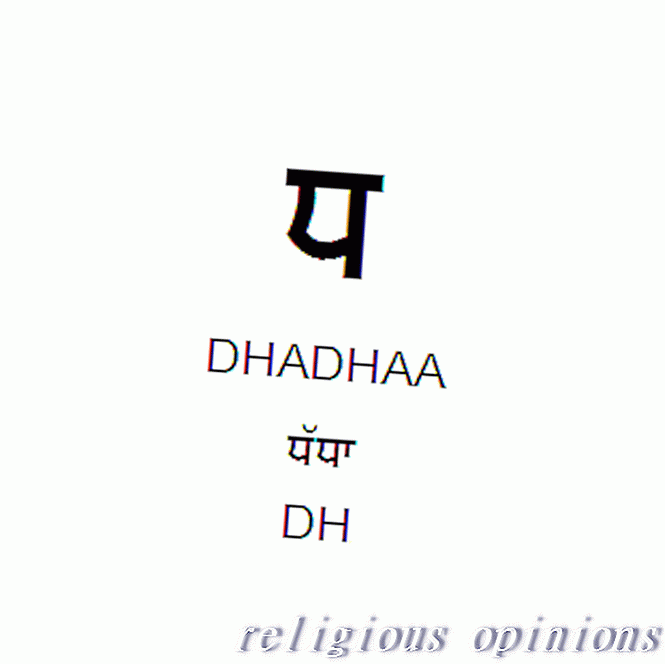 Punjabi Akhar Dhadhaa Significance in Sikh Scripture Gurmukhi Script Dhadhaa. Foto [S Khalsa]
Punjabi Akhar Dhadhaa Significance in Sikh Scripture Gurmukhi Script Dhadhaa. Foto [S Khalsa] Dhadhaa is a consonant of the Gurmukhi alphabet.
DH - Gurmukhi Dhadhaa Pronunciation Guide
Dhadhaa is a consonant of the 35 Gurmukhi akhar of Gurbani and identical to the Punjabi alphabet.
Dhadhaa represents an DH sound as in Dha-dhaw with emphasis on the second syllable and is pronounced with the tongue pressed against the back of the upper teeth so that when spoken there is a puff of air felt when the hand is held in front of the lips. The Romanized spelling of Dhadhaa is phonetic and may also appear spelled as Dhadha . Spellings may differ slightly in original Gurmukhi as well as Romanized and English translations of Gurbani.
Significance of Dhadhaa in Sikh Scripture
Guru Granth Sahib scripture includes acrostic form of poetic verse written by first Guru Nanak as a young boy. The lad amazed his teacher who teacher expressed astonishment when the child Nanak Dev wrote:
" Dhadhai dhaar kalaa jin chhoddee har cheejee jin rang kee-aa ||
DHADHA: The earth has been established and upheld by the Lord who has imparted His coloring to everything." SGGS||433
" Dhadhai dharam dharae dharmaa pur gunkaaree man dheeraa ||
DHADHA: Those who enshrine devotion dwell in the city of faith are the worthy ones whose minds are steadfast and stable.
Dhadhhai dhool parrai mukh mastak kanchan bha-ae manooraa ||
DHADHA: The dust of such saints' feet alighting upon one's face and forehead, transforms that one from iron to gold." SGGS||930
Other acrostic verses in Gurbani featuring Dhadhaa includesignifigant shabads composed by:
Fifth Guru Arjan Dev:
" Dhadhaa dhoor puneet tere janoo-aa ||
DHADHA: The dust beneath the feet of the holy is sacred." SGGS||251
" Dhadhaa dhaavat tou mittai santsang ho-e baas ||
DHADHA: Wanderings cease when one attains an abode in the Saint's association." SGGS||257
Bhagat Kabir:
" Dhadhaa aradheh ouradh nibaeraa ||
DHADHA: Everything is resolved when one turns about and ascends from the lower realms of earth to the higher realms of heaven." Kabir SGGS||341
Third Guru Amar Das:
" Dhadhai dhaavat varaj rakh moorrae antar terai nidhaan pa-i-aa ||
DHADHA: Restrain your wanderings O fool, within you is found the treasure." SGGS||435
Gurmukhi Alphabet Nanaa of Gurbani Illustrated With Pronunciation
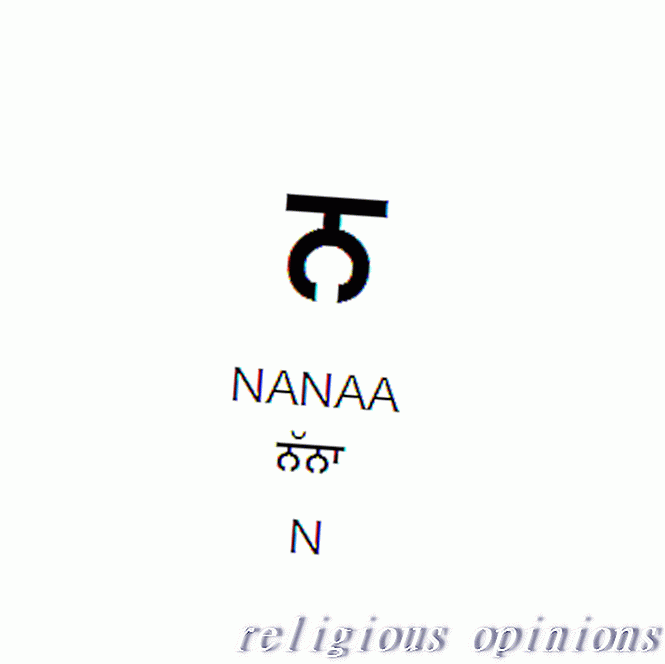 Punjabi Akhar Nanaa Significance in Sikh Scripture Gurmukhi Script Nanaa. Foto [S Khalsa]
Punjabi Akhar Nanaa Significance in Sikh Scripture Gurmukhi Script Nanaa. Foto [S Khalsa] Nanaa is a consonant of the Gurmukhi alphabet.
N - Gurmukhi Nanaa Pronunciation Guide
Nanaa is a consonant of the 35 Gurmukhi akhar of Gurbani and is identical to the Punjabi alphabet.
Nanaa represents an N sound as in na-naw with emphasis on the second syllable and is pronounced so that the tongue touches the back of the upper teeth. There should be no puff of air when the hand is held in front of the lips. The Romanized spelling of Nanaa is phonetic and may also appear spelled as Nannaa . Spellings may differ slightly in original Gurmukhi as well as Romanized and English translations.
Significance of Nanaa in Sikh Scripture
Sikh scripture includes acrostic form of poetic verse written by first Guru Nanak as a young boy when given a homework assignment in school by his teacher to write the alphabet. His teacher expressed astonishment when the child Nanak Dev wrote:
" Nannai naah bhog nit bhogai naa ddeethhaa naa sanmhaliaa ||
NANNA: The Husband Lord enjoys ever the pleasures, but is neither seen nor understood." SGGS||433
Other acrostic style shabads featuring Nanaa by the authors of Guru Granth Sahib include:
Fifth Guru Arjan Dev:
" Nannaa narak pareh tae naahee ||
NANNA: Into Narak (hell) they fall not." SGGS||257
" Sidhhan-ngaa-i-ai simareh naahee nannai naa tudh naam la-i-aa ||
Sidhan, Ngaayiyai: You remember Him not, NANNA: nor do you indulge in His name." SGGS||434
Bhagat Kabir:
" Nannaa nis din nirakhat jaaee ||
NANNA: The nights and days go by while I pass them looking for the Lord." Kabir SGGS||340
Gurmukhi Alphabet Papaa of Gurbani Illustrated With Pronunciation
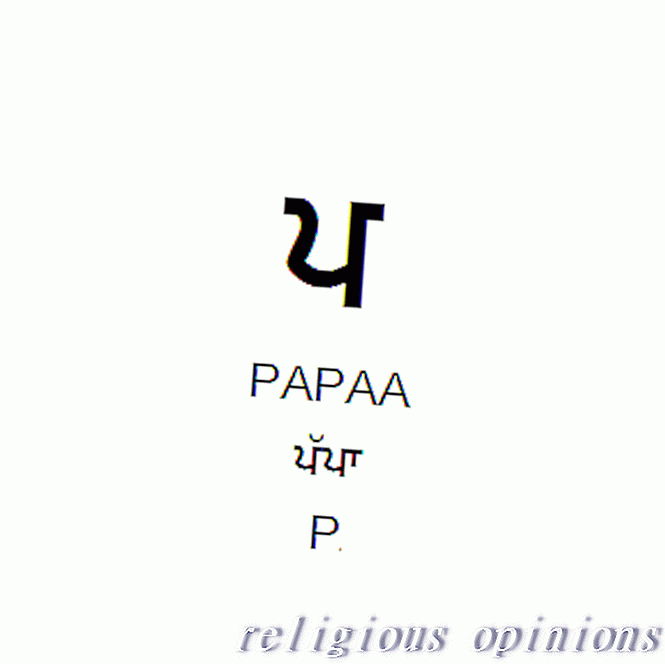 Punjabi Akhar Papaa Significance in Sikh Scripture Gurmukhi Script Papaa. Foto [S Khalsa]
Punjabi Akhar Papaa Significance in Sikh Scripture Gurmukhi Script Papaa. Foto [S Khalsa] Papaa is a consonant of the Gurmukhi alphabet.
P - Gurmukhi Papaa Pronunciation Guide
Papaa is a consonant of the 3k akhar of Gurmukhi script and is identical to the Punjabi alphabet.
Papaa is represented by P and pronounced as pa-paw, with emphasis on the second syllable. The lips must first be pressed together then open to form the sound of Pa. There should be no puff of air when when the hand is held in front of the lips as Papaa is spoken. The Romanized spelling of Papaa is phonetic and may also appear spelled as Pappa . Spellings may differ slightly in original Gurmukhi as well as Romanized and English translations of Gurbani.
Significance of Papaa in Sikh Scripture
Sikh scripture includes acrostic poetic verses featuring Gurmukhi consonant Papaa in the shabads of Gurbani.
When writing verses Guru Nanak, first of the Sikh gurus, astonished his instructors as a young boy with his spiritual insights:
" Papai paatisaahu parmaesar vaekhann ko parpanch kee-aa ||
PAPPA: The Supreme King and Transcendent Lord created the world and watches over it." SGGS||433
Other acrostic verses in Guru Granth Sahib by various authors of Gurbani include:
" Papaa parmit paar na paa-i-aa ||
PAPPA: He is beyond estimating, His limits cannot be discovered." SGGS||258 Fifth Guru Arjan Dev
" Papaa apar paar nehee paavaa ||
PAPPA: He is boundless his boundaries can never be known." SGGS||341 Bhagat Kabir
" Papai paar na pavehee moorrae parpanch toon palach rehiaa ||
PAPPA: You shall not swim across, O fool, as you are engrossed in worldly affairs." SGGS||435 Third Guru Amar Das
Gurmukhi Alphabet Phaphaa of Gurbani Illustrated With Pronunciation
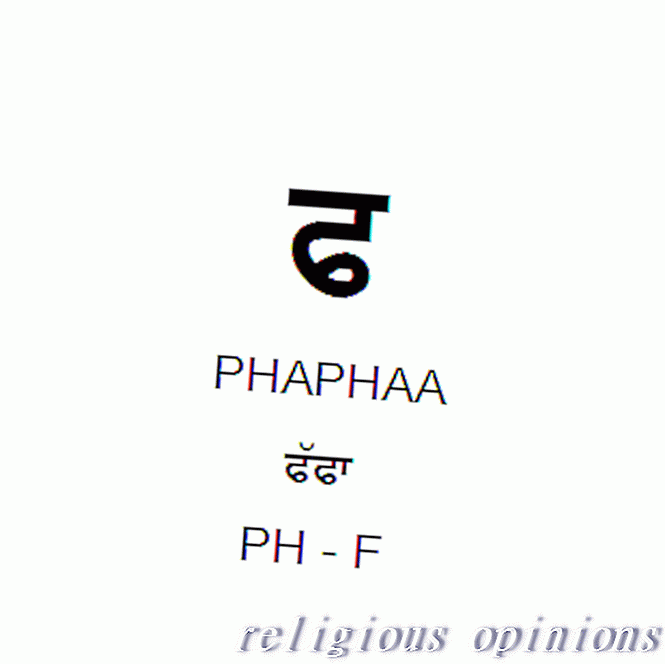 Punjabi Akhar Phaphaa Significance in Sikh Scripture Gurmukhi Script Phaphaa. Foto [S Khalsa]
Punjabi Akhar Phaphaa Significance in Sikh Scripture Gurmukhi Script Phaphaa. Foto [S Khalsa] Phaphaa is a consonant of the Gurmukhi alphabet.
Ph - Gurmukhi Phaphaa Pronunciation Guide
Phaphaa is a consonant of the 35 akhar of Gurmukhi script and is identical to the Punjabi alphabet.
Phaphaa is represented by PH as in elephant and is pronounced as pha-phaw, with emphasis on the second syllable. The Romanized spelling of Phaphaa is phonetic and may also appear spelled as Phapha and occasionally F is or Faffa is used, however PH is more correct as the sound is fully aspirated. Note the difference between saying fork and elephant or phosphorous while holding the hands to the lips. The lips must first be pressed together and then open to make the sound. A distinct puff of air should be felt when said while holding the hand in front of the lips. Spellings may also differ slightly in original Gurmukhi as well as Romanized and English translations of Gurbani.
Significance of Phaphaa in Sikh Scripture
Sikh scripture includes the acrostic form of poetic verse featuring Phaphaa of the Gurmukhi alphabet and appears throughout the Guru Granth Sahib.
As a child, Guru Nanak, the first Sikh guru, astonished his instructors when he presented them with an alphabetical spiritual acrostic:
" Phaphai phaahee sabh jag phaasaa jam kai sangal bandh la-i-aa ||
PHAPHA: The whole world is entangled in the noose of Death, and bound by its chains." SGGS||433
Acrostic verses by other authors of Gurbani featuring Phaphaa include:
" Phaphaa phirat phirat too aa-i-aa ||
PHAPHA: After wandering and wandering, at long last you have come." SGGS||258 Fifth Guru Arjan Dev
" Phaphaa bin phooleh phal ho-ee ||
PHAPHA: Without flowering, the fruit is produced." SGGS||340 Bhagat Kabir
Gurmukhi Alphabet Babaa of Gurbani Illustrated With Pronunciation
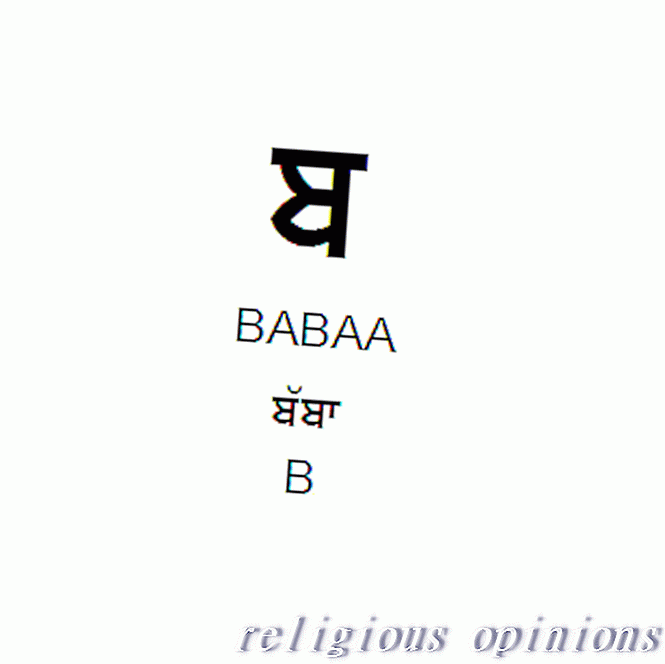 Punjabi Akhar Babaa Significance in Sikh Scripture Gurmukhi Script Babaa. Foto [S Khalsa]
Punjabi Akhar Babaa Significance in Sikh Scripture Gurmukhi Script Babaa. Foto [S Khalsa] Babaa is a consonant of the Gurmukhi alphabet.
B - Gurmukhi Babaa Pronunciation Guide
Babaa is a consonant of the Gurmukhi 35 akhar and is the same as the Punjabi alphabet.
Babaa is represented by B and pronounced as ba-baw, with emphasis on the second syllable. The lips must first be pressed together then open to form the sound of Ba. There should be no puff of air when when the hand is held in front of the lips. The Romanized spelling of is phonetic and may also appear spelled as Babba . Spellings may differ slightly in original Gurmukhi as well as Romanized and English translations of Gurbani.
Significance of Babaa in Sikh Scripture
Sikh scripture includes a form of poetic verse appearing the Guru Granth Sahib that features the Babaa character of the Gurmukhi alphabet.
Guru Nanak, the first Sikh guru, greatly impressed his tutpor when as a young boy he composed a spiritual acrostic:
" Babai baajee khaelan laagaa chouparr keetae chaar jugaa ||
Babba: He began to play the game, using as His dice-cloth, the four ages." SGGS||433
Various authors also composed acrostic verses of Gurbani featuring Babaa including:
" Babaa breham jaanat tae brehmaa ||
BABBA: One who divines (intuitively comes to know) the Supreme Divine is known as a Brahmin." SGGS||258 Fifth Guru Arjun Dev
" Babaa bindeh bind milaavaa ||
BABBA: The drip and drop blend together." SGGS||340 Bhagat Kabir
" Babai boojheh naahee moorrae bharam bhulae teraa janam ga-i-aa ||
BABBA: You understand not O fool, deluded by doubt your life wastes away." SGGS||434 Third Guru Amar Das
Gurmukhi Alphabet Bhabhaa of Gurbani Illustrated With Pronunciation
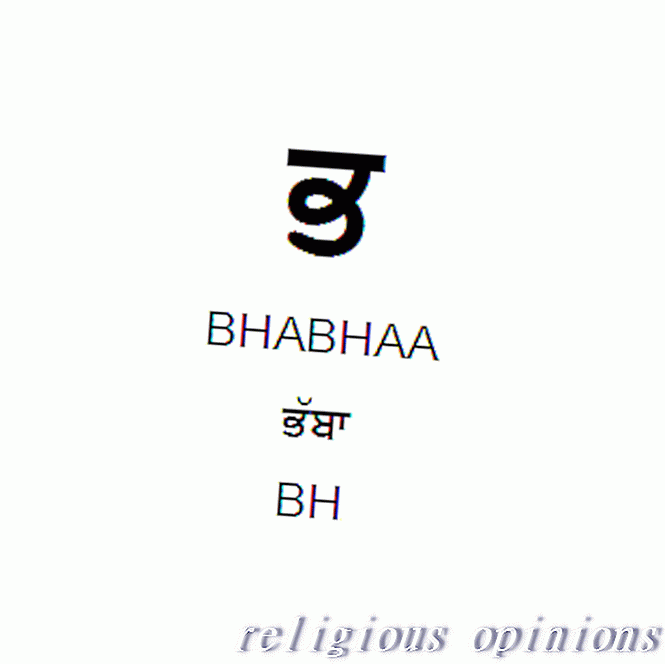 Punjabi Akhar Bhabhaa Significance in Sikh Scripture Gurmukhi Script Bhabhaa. Foto [S Khalsa]
Punjabi Akhar Bhabhaa Significance in Sikh Scripture Gurmukhi Script Bhabhaa. Foto [S Khalsa] Bhabhaa is a consonant of the Gurmukhi alphabet.
BH- Gurmukhi Bhabhaa Pronunciation Guide
Bhabhaa is a consonant of the Gurmukhi script 35 Akhar and is the same as that of the Punjabi alphabet.
Bhabhaa is pronounced as bha-bhaw, with emphasis on the second syllable. The lips must first be pressed together and then open to make the sound. The Romanized spelling of Bhabhaa is phonetic and may also appear spelled as Bhabha . Spellings may also differ slightly in original Gurmukhi as well as Romanized and English translations of Gurbani. For Romanized transliteration purposes in Gurbani scripture, Bhabhaa is most often represented by BH but sometimes is written as P for non scriptural purposes when writing Romanized Punjabi, because as in the English way of saying P, a distinct puff of air should be felt when the hand is held in front of the lips. For example the Punjabi word word for sister might be spelled Bhainji or Penji in Roman letters.
Significance of Bhabhaa in Sikh Scripture
Sikh scripture includes the acrostic form of poetic verse featuring Bhabhaa of the Gurmukhi alphabet and appears throughout the Guru Granth Sahib.
Guru Nanak Dev, first of the Sikh gurus, astonished his instructors when as a young boy given a homework assignment in school to write the alphabet, the child responded with a spiritual acrostic:
" Bhabhai bhaaleh se phal paaveh gur parsaadee jinh ko bho pa-i-aa ||
BHABHA: Those who seek are fruitful by the Enlightener's grace, and they become God-fearing." SGGS||434
Other signifigant acrostic shabads by various authors of Guru Granth Sahib include:
" Bhabhaa bharam mittaavhu apanaa ||
BHABHA: Cast off your doubt." SGGS||258 Fifth Guru Arjan Dev
" Bhabhaa bhaedeh bhaed milaavaa ||
BHABHA: Dispelling doubt divine union is achieved." SGGS||342 Bhagat Kabir
" Bhabhai bhavjal ddubohu moorrae maa-i-aa vich galtaan bha-i-aa ||
BHABHA: You have drowned in the terrible world-ocean, O fool, while engrossed in Maya's illusory wealth." SGGS||435 Third Guru Amar Das
Gurmukhi Script Mamaa of Gurbani Illustrated With Pronunciation
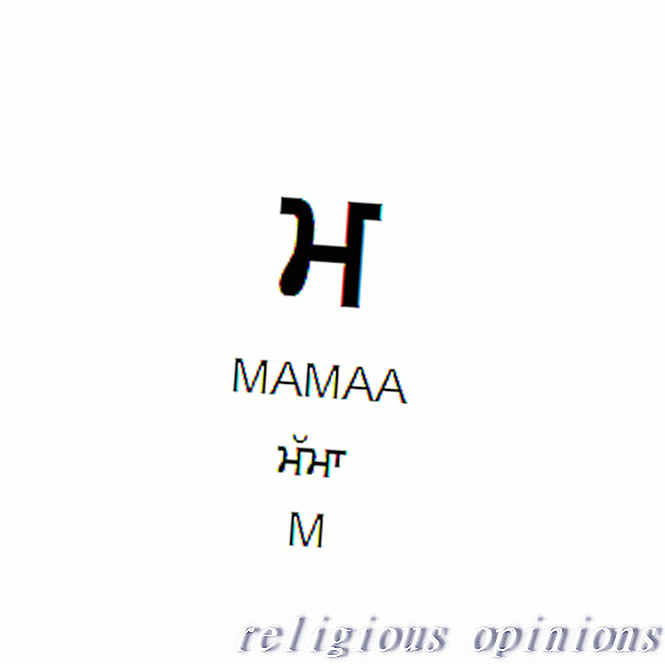 Punjabi Akhar Mamaa Significance in Sikh Scripture Gurmukhi Script Mamaa. Foto [S Khalsa]
Punjabi Akhar Mamaa Significance in Sikh Scripture Gurmukhi Script Mamaa. Foto [S Khalsa] Mamaa is a consonant of the Gurmukhi alphabet.
M - Gurmukhi Mamaa Pronunciation Guide
Mamaa is a consonant of the Gurmukhi script 35 akhar of Gurbani and is the same as its Punjabi alphabet counterpart.
Mamaa is represented by M and is pronounced as Ma-maw, with emphasis on the second syllable. The Romanized spelling of Mamaa is phonetic and may also appear spelled as Mamma . The lips must first be pressed together and then open to make the sound. No puff of air should be felt when said while holding the hand in front of the lips. Spellings may also differ slightly in original Gurmukhi as well as Romanized and English translations of Gurbani.
Significance of Mamaa in Sikh Scripture
Scripture of the Guru Granth Sahib includes poetic verses featuring Mamaa of the Gurmukhi alphabet. Teachers were wonderstruck when their student Guru Nanak, the first Sikh guru, presented them with a spiritual acrostic:
" Manmai mohu maran madhu-soodhan maran bha-i-aa tab chaetaviaa ||
Mamma: Attached to worldly love, only upon death does the mortal think of the Destroyer of Demon then dying God's (Immortal) Nectar is remembered." SGGS||434
Other verses featuring Mamaa in Gurbani include acrostic selections by authors:
Fifth Guru Arjun Dev:
" Mamaa maaganehaar i-aanaa ||
MAMMA: The poser is clueless." Guru Arjun Dev SGGS||258
" Mamaa jaahoo maram pachhaanaa ||
MAMMA: One having perception of divine mysteries." SGGS||259
Bhagat Kabir:
" Mamaa mool gehiaa man maanai ||
MAMMA: When its origin is adhered to the soul is satiated." SGGS||342
" Mamaa man sio kaaj hai man saadhae sidh ho-e ||
MAMMA: The mind is busily pre-occupied, the mind when disciplined attains perfection." Kabir SGGS||342
Third Guru Amar Das:
" Manmai mat hir la-ee teree moorrae houmai vaddaa rog pa-i-aa ||
MAMMA: Your intellect has been plundered, O fool, pride has greatly afflicted you." SGGS||435
Gurmukhi Alphabet Yayaa of Gurbani Illustrated With Pronunciation
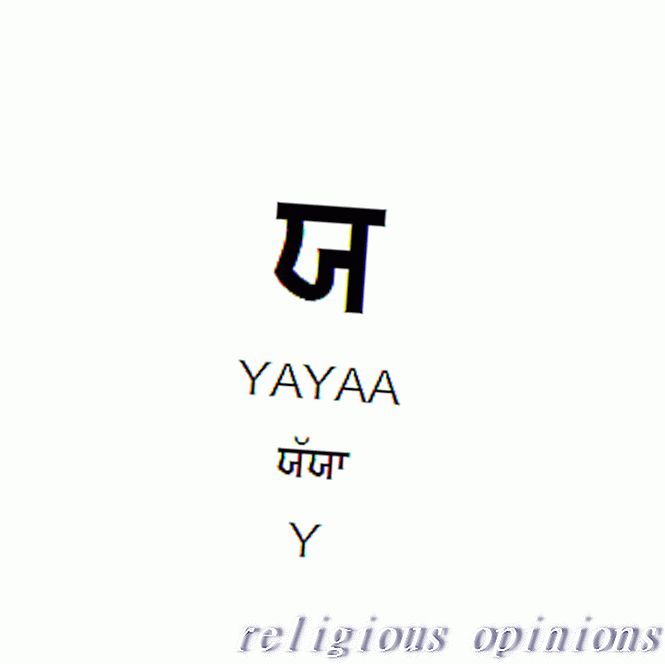 Punjabi Akhar Yayaa Significance in Sikh Scripture Gurmukhi Script Yayaa. Foto [S Khalsa]
Punjabi Akhar Yayaa Significance in Sikh Scripture Gurmukhi Script Yayaa. Foto [S Khalsa] Yayaa is a consonant of the Gurmukhi alphabet.
Y - Gurmukhi Yayaa Pronunciation Guide
Yayaa is a consonant of the 35 akhar Gurmukhi script of Gurbani and identical to its Punjabi alphabet counter part.
Yayaa is represented by Y and is pronounced as ya-yaw with the emphasis on the second syllable. The Romanized spelling of Yayaa is phonetic and may also appear spelled as Yayya . Spellings may differ slightly in original Gurmukhi as well as Romanized and English translations of Gurbani.
Significance of Yayaa in Sikh Scripture
Guru Nanak the first Sikh guru Sikh composed acrostic hymns featuring Yayaa as a young student:
" Yayai janam na hovee kad hee je kar sach pachhaannai ||
YAYYA: Birth is not taken again by one who realizes the True Lord." SGGS||434
Fifth Guru Arjan Dev also composed similar style alphabetical acrostic shabads:
" Yayaa jaaro duramat do-oo ||
YAYYA: Burn away the egoistic toughts of double-mindedness.
Tiseh tiaag sukh sehajae so-oo ||
Relinquish them and sleep peacefully in equipoise.
Yayaa jaa-e parhu sant sarnaa ||
YAYYA: Go seek refuge of the Saints.
Jeh aasar e-aa bhavjal taranaa ||
With their help, the terrible world-ocean is crossed over.
" Yayaa janam na aavai so-oo ||
YAYYA: Birth is not taken again.
Ek naam lae maneh paro-oo ||
When the One name is taken with in the heart.
Yayaa janam na haaree-ai gur poorae kee ttaek ||
YAYYA: This lifetime shall not be wasted, if one has support of the Pure Enlightener.
Naanak teh sukh paa-i-aa jaa kai hee-a-rai ek ||14||
O Nanak, One finds peace with one's heart heart on attaining the One Lord." ||14|| Guru Arjun Dev SGGS||253
" Yayaa jatan karat bahu bidhee-aa ||
YAYYA: People make efforts of may kinds.
Ek naam bin keh lo sidhee-aa ||
Without the One Name, how far can anyone succeed?" SGGS||259
Bhagat Kabir a 15th century saint composed hymns in the acrostic style as well:
" Yayaa jo jaaneh tou duramat han kar bas kaa-i-aa gaa-o ||
YAYYA: If you comprehend anything, then destroy your double-mindedness and subdue the body-village." SGGS||342
Gurmukhi Alphabet Raaraa of Gurbani Illustrated With Pronunciation
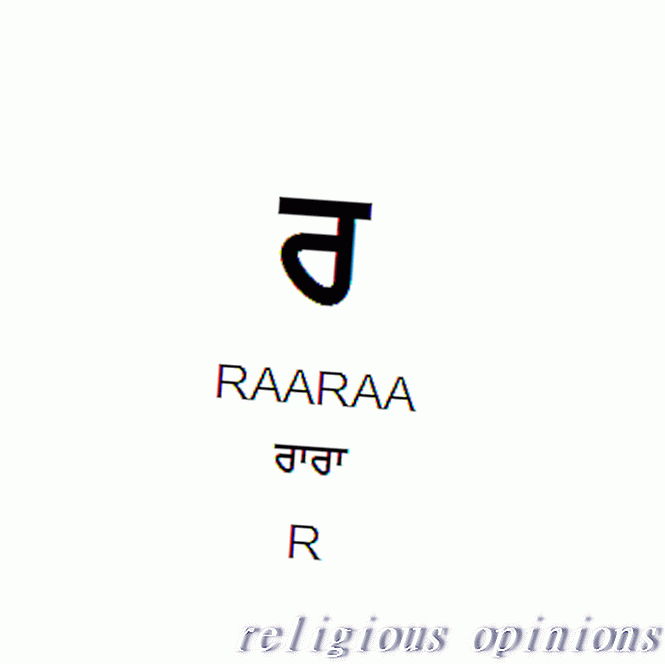 Punjabi Akhar Raaraa Significance in Sikh Scripture Gurmukhi Script Raaraa. Foto [S Khalsa]
Punjabi Akhar Raaraa Significance in Sikh Scripture Gurmukhi Script Raaraa. Foto [S Khalsa] Raaraa is a consonant of the Gurmukhi alphabet.
R - Gurmukhi Raaraa Pronunciation Guide
Raaraa is a consonant of the Gurmukhi script 35 akhar and identical to its Punjabi alphabet counterpart.
Raaraa is a symbol for R and is pronounced with the tongue forward, is rolled and sounds like are-rrr. Raaraa is phonetic and may also appear spelled as Rarra . Spellings may differ slightly in original Gurmukhi as well as Romanized and English translations of Gurbani.
Significance of Raaraa in Sikh Scripture
Sikh scripture of the Guru Granth Sahib includes the acrostic form of poetic verse featuring Raaraa of the Gurmukhi alphabet.
First Guru Nanak Dev, astonished his instructors when as a young boy given an assignment in school to write the alphabet, the child responded with a spiritual acrostic:
" Raarai rav rehiaa sabh antar jaetae kee-ae jantaa ||
RARRA: The Lord is contained among all beings He created." SGGS||434
Other authors of Guru Granth Sahib also composed signifigant alphabetical shabads in the acrostic style including:
Fifth Guru Arjan Dev:
" Raaraa rangahu iaa man apanaa ||
RARRA: Dye this thy heart with Love of the Lord." SGGS||252
" Raaraa raen hot sabh jaa kee ||
RARRA:Be the dust beneath the feet of all." SGGS||259
15th Century Saint Bhagat Kabir:
" Raaraa ras niras kar jaaniaa ||
RARRA: Worldly tastes I have found to be tasteless." SGGS||342
Third Guru Amar Das:
" Raarai raam chit kar moorrae hiradhai jinh kai rav rehiaa ||
RARRA: Remember the Lord and abide with those in whose heart he is ever present. SGGS||435
Gurmukhi Alphabet Lalaa of Gurbani Illustrated With Pronunciation
 Punjabi Akhar Lalaa Significance in Sikh Scripture Gurmukhi Script Lalaa. Foto [S Khalsa]
Punjabi Akhar Lalaa Significance in Sikh Scripture Gurmukhi Script Lalaa. Foto [S Khalsa] Lalaa is a consonant of the Gurmukhi alphabet.
L - Gurmukhi Lalla Pronunciation Guide
Lalaa is a consonant of the 35 akhar Gurmukhi script of and is identical to its Punjabi alphabet counterpart.
Lalaa has the sound of L and is pronounced with the emphasis on the second syllable like sa-saw. The Romanized spelling of Lalaa is phonetic and may also appear spelled as Lalla, or Lallaa . Spellings may differ slightly in original Gurmukhi as well as Romanized and English translations of Gurbani.
Significance of Lalaa in Sikh Scripture
Guru Granth Sahib scripture includes an acrostic form of alphabetical poetic hymns featuring the Gurmukhi consonant Lalaa .
The teacher expressed astonishment when as a young school boy First Guru Nanak Dev wrote:
" Lalai laa-e dhandhhai jin chhoddee meethhaa maa-i-aa mohu kee-aa ||
LALLA: He who assigned the created beings to their tasks, has made such illusory involvement seem sweet to them." SGGS||434
Fifth Guru Arjan Dev also composed alpabetical shabads featuring Lalaa including:
" Lalaa lapatt bikhai ras raatae ||
LALLA: Entangled, they are tainted by their taste for corrupt pleasures." SGGS||252
" Lalaa taa kai lavai na ko-oo ||
LALLA: Equal to Him, there is none." SGGS||252
" Lalaa laavo aoukhadh jaahoo ||
LALLA: Apply the medicine of God's name." SGGS||259
Bhagat Kabir also wrote featuring Lalaa in the acrostic style:
" Lalaa aisae liv man laavai ||
LALLA: Embrace devotional love and to your heart apply it" SGGS||342
Gurmukhi Alphabet Vaavaa of Gurbani Illustrated With Pronunciation
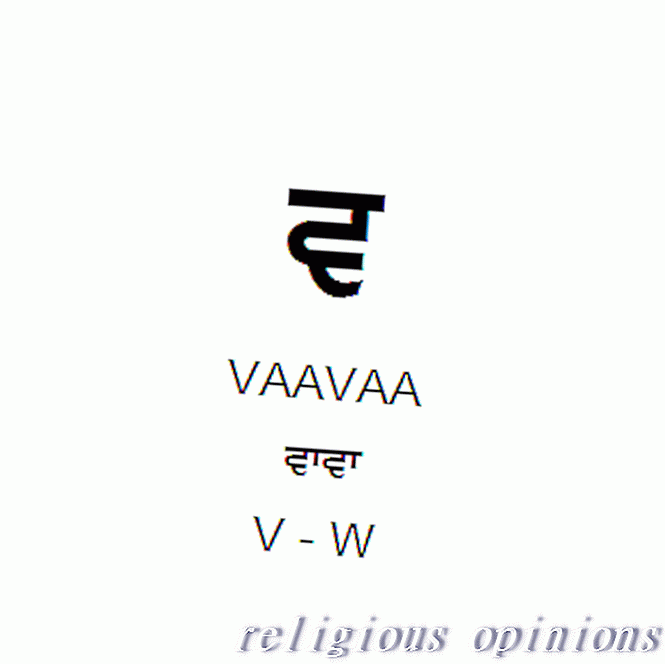 Punjabi Akhar Vaavaa Significance in Sikh Scripture Gurmukhi Script Vavaa. Foto [S Khalsa]
Punjabi Akhar Vaavaa Significance in Sikh Scripture Gurmukhi Script Vavaa. Foto [S Khalsa] Vaavaa is a consonant of the Gurmukhi alphabet.
V - Gurmukhi Vaavaa Pronunciation Guide
Vaavaa is a consonant of the 35 akhar Gurmukhi script of Gurbani and identical to its Punjabi alphabet counter part.
Vavaa may be represented by or V or W and is pronounced with the upper teeth touching the bottom lip with emphasis equally on both syllables so that it produces a sound between the English vaw-vaw and waw-waw. The Romanized spelling of Vaavaa is phonetic and may also appear spelled as Vava or Waawaa etc.. Care should be taken to produce the sound blending V or W which may sometimes be misrepresented or misprounounced by B such as commonly substituting the spelling of Baisakhi for Vaisakhi, though it is seldom, if ever, spelled Waisakhi . Spellings may also differ slightly in original Gurmukhi as well as Romanized and English translations of scripture of Gurbani. Words are to be pronounced as written in scripture, which is why it is important to learn to recognize Gurmukhi script. For example the following words have several ways of being spelled:
Bikram and Vikram are both common, though probably not Wikram .
Gobind is most common, but may also be spelled as Govind and even Gowind .
Significance of Vaavaa in Sikh Scripture
Sikh scripture includes several acrostic form of poetic verse featruing Vavaa written by various authors of Guru Granth Sahib:
First Guru Nanak Dev impressed his tutors with his spiritual outlook and insights when as a student he wrote:
" Vavai vaasudae-ou parmaesar vaekhann ko jin vaes kee-aa ||
WAWWA: The all-pervading Transcendent Master oversees the world having created the form it wears." Fiorst Guru Nanak Dev SGGS||434
Fifth Guru Arjan Dev framed spiritual lessons within his acrostic style shabad:
" Vavaa vair na karee-ai kaahoo ||
WAWWA: Harbor not hatred against anyone." Guru Arjun Dev SGGS||259
15th century saint and poet Bhagat Kabir wrote an alphabetical compostion featuring Vavaa:
" Vavaa baar baar bisan samhaar ||
WAWWA: Again and again, dwell upon the abode of the Lord Master." SGGS||342
Third Guru Amar Das also favored the acrostic style of alphabetical composition:
" Vavai vaaree aa-ee-aa moorrae vaasudae-o tudh veesar-i-aa ||
WAWWA: Your turn has come, O fool, but you have forgotten the Luminous Lord. SGGS||435
Gurmukhi Alphabet Rrarraa of Gurbani Illustrated With Pronunciation
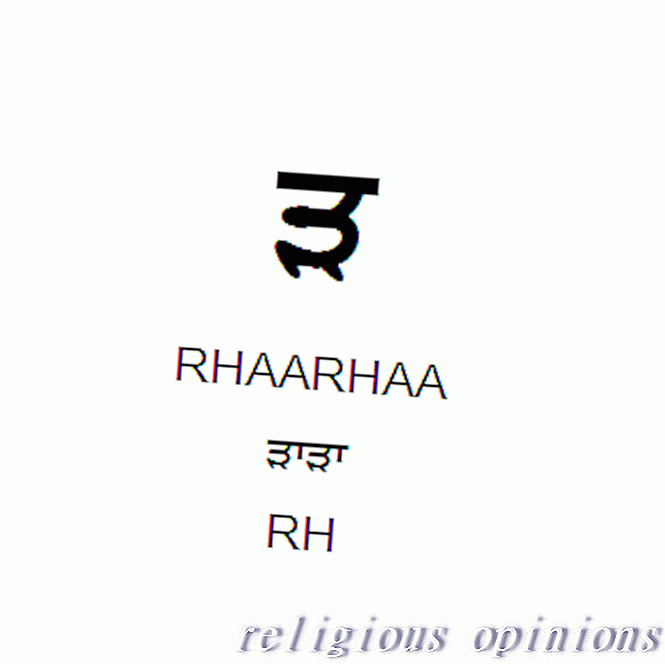 Punjabi Akhar Rrarraa Significance in Sikh Scripture Gurmukhi Script Rharhaa. Photo © [S Khalsa]
Punjabi Akhar Rrarraa Significance in Sikh Scripture Gurmukhi Script Rharhaa. Photo © [S Khalsa] Rrarraa is a consonant of the Gurmukhi alphabet
RR - Gurmukhi Rrarraa Pronunciation Guide
Rrarraa is a consonant of the 35 akhar Gurmukhi script featured in Gurbani and is identical to its Punjabi alphabet counterpart.
Rraarraa is pronounced with the tongue curled back to touch just behind the ridge at the roof of the mouth and sounds like ra. The Romanized spelling of Rraarraa is phonetic and may also appear spelled as Rhaarhaa . Other phonetic spellings may differ slightly in original Gurmukhi as well as Romanized and English translations of Gurbani depending on gramatical usage.
Significance of Rrarraa in Sikh Scripture
Several authors of Gurbani composed shabads in the acrostic style which feature the Gurmukhi consonant Rrarraa in Guru Granth Sahib scripture:
First Guru Nanak Dev showed his spiritual depth of character as a young student when we wrote:
" Rraarrai raarr kareh kiaa praanee tiseh dhiaavhu je amar hoaa ||
RRARRA: Why quarrel O mortal? Meditate on the imperishable Lord." SGGS||434
Fifth Guru Arjan Dev used various grammatical forms of Rrarraa in his acrostic shabad:
" Rraarraa rraar mittai sang sadhoo ||
RRARRA: Conflict is eliminated when associating with true the pious.
Karam dharam tat naam araadhoo ||
The essence of religious rites and creeds is meditation done in adoration of the Lord's Name.
Roorho jih basiou ridh maahee ||
In the heart of whom the Beauteous Lord abides,
Ouaa kee rraarr mittat binsaahee ||
Strife is erased, eliminated.
Rraarr karat saakat gaavaaraa ||
The opinionated argue foolishly in faithless disputes.
Jaeh heeai ahnbudh bikaaraa ||
Whose heart is filled with prideful intellect in ignorance bickers.
Rraarraa gurmukh rraarr mittaaee ||
RRARRA: Dispute is settled by the enlightened mouth which ceases to quarrel.
Nimakh maahe naanak samjhaaee ||47||
In an instant the Exalted instructor, O Nanak, is understood." SGGS||260
Gurmukhi Alphabet Ik Onkar of Gurbani Illustrated With Pronunciation
 Ik Onkar Significance in Sikh Scripture Ik OanKar. Photo © [S Khalsa]
Ik Onkar Significance in Sikh Scripture Ik OanKar. Photo © [S Khalsa] Ik Onkar is a combination character of the Gurmukhi Script.
Gurmukhi Pronunciation Guide to Ik Onkar
Ik Onkar is a combination character featuring the Gurmukhi numeral 1 and is symbolic of One Creator and Creation, in the verse Mool Mantar which appears at the very beginning of Gurbani, and throughout Sikh Scripture.
Ik Onkar is a phonetic spelling and may also be spelled Ik Oankar or Ek Onakaar . Broken into parts both word and symbol are correctly pronounced with stress on the vowels Ik-O-An-Kar:
Ik has a short i sound as in lick.
O has a long o sound as in oat.
An has short a sound like the u in un.
Kaar has a long aa sound as in car.
Significance of IK Onkar in Sikh Scripture
The character Ik Onkar, and the word Onkar, both signify in the scripture of Guru Granth Sahib and are featured together in the acrostic verses of poet Bhagat Kabir:
" Ik Onkar satnaam kartaa purkh gurprasaad ||
One creator at one with creation, a truly identifiable creative personalty, realized by the Enlightener's grace." SGGS||340
" Oankaar aad mai jaanaa ||
I know only the One Creative Original Being.
Likh ar maettai taa-eh na maanaa ||
What is written is also erased, I believe not in the perishable.
Oankaar lakhai jo koee ||
Creator and creation, behold them (as One).
So-ee lakh maettanaa na hoee ||6||
One seeing (and understanding) this, perishes not." ||6|| SGGS||340



